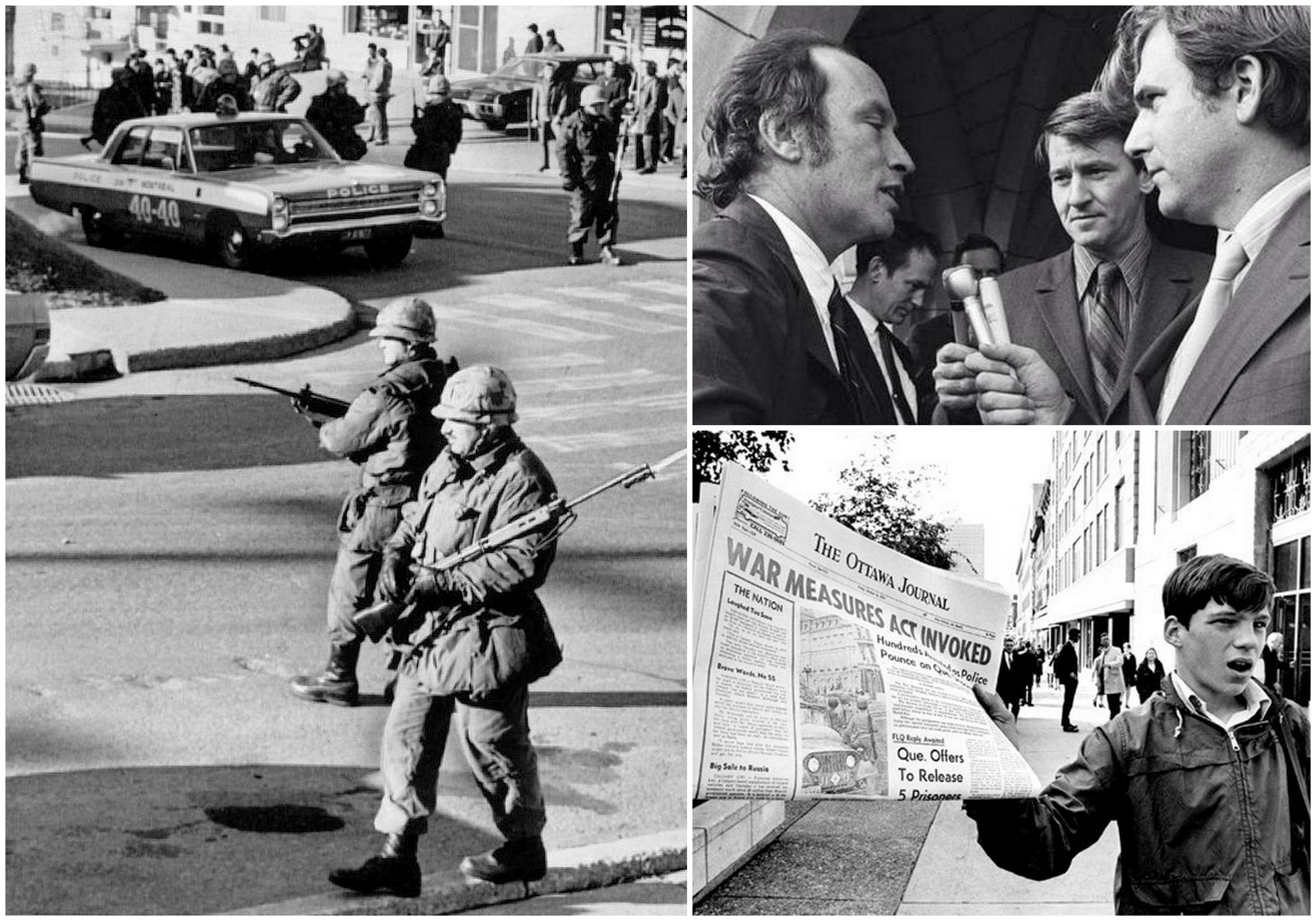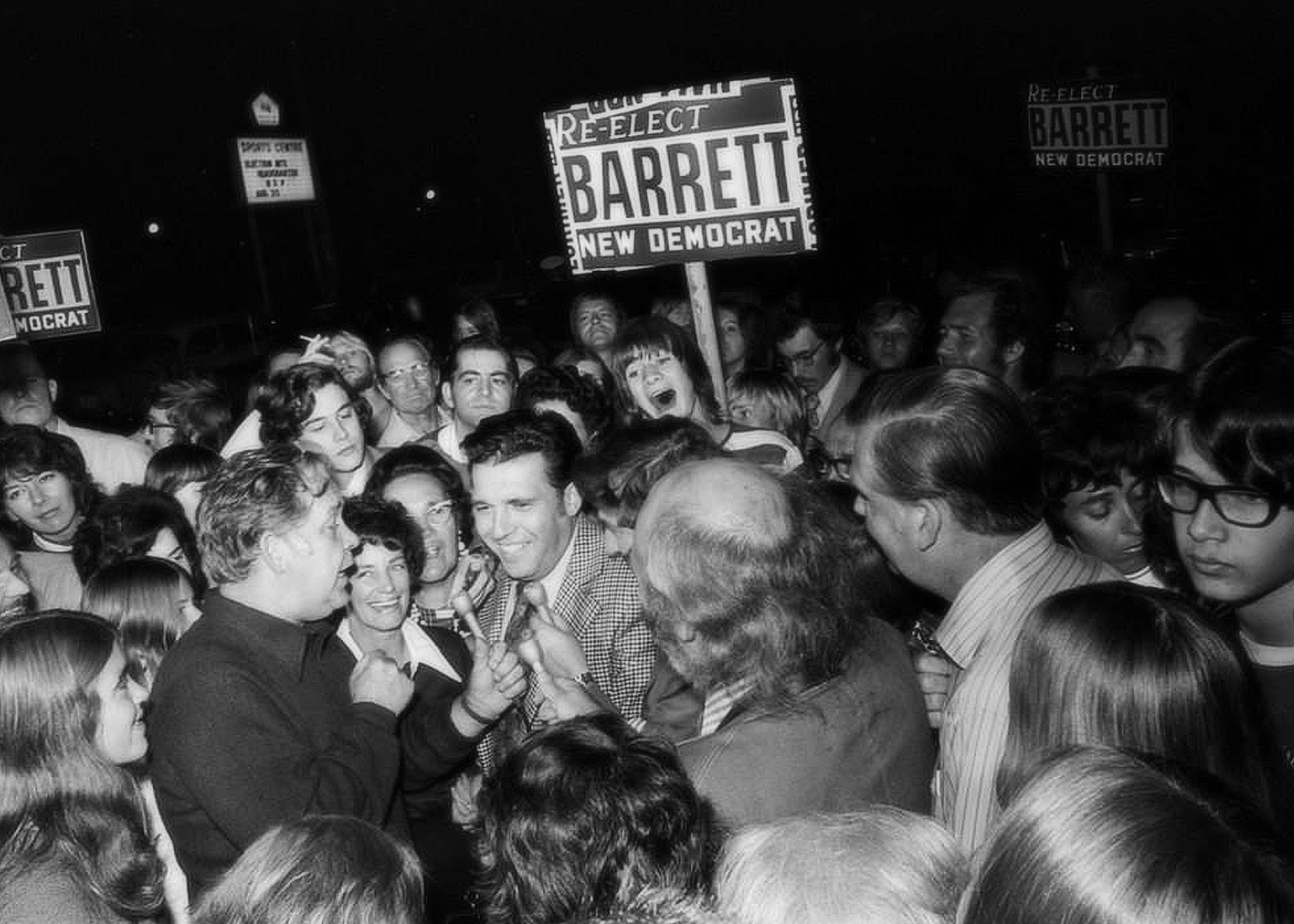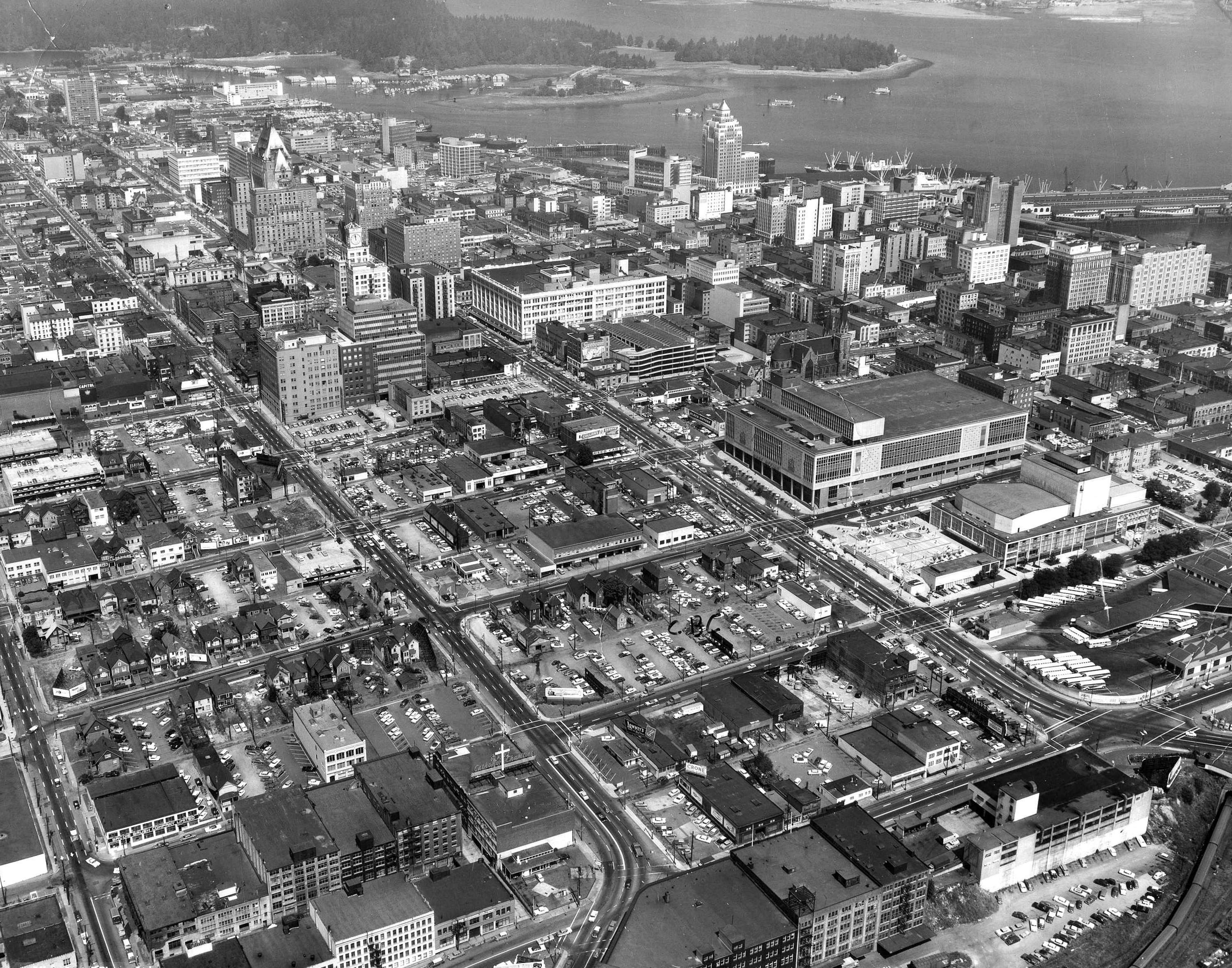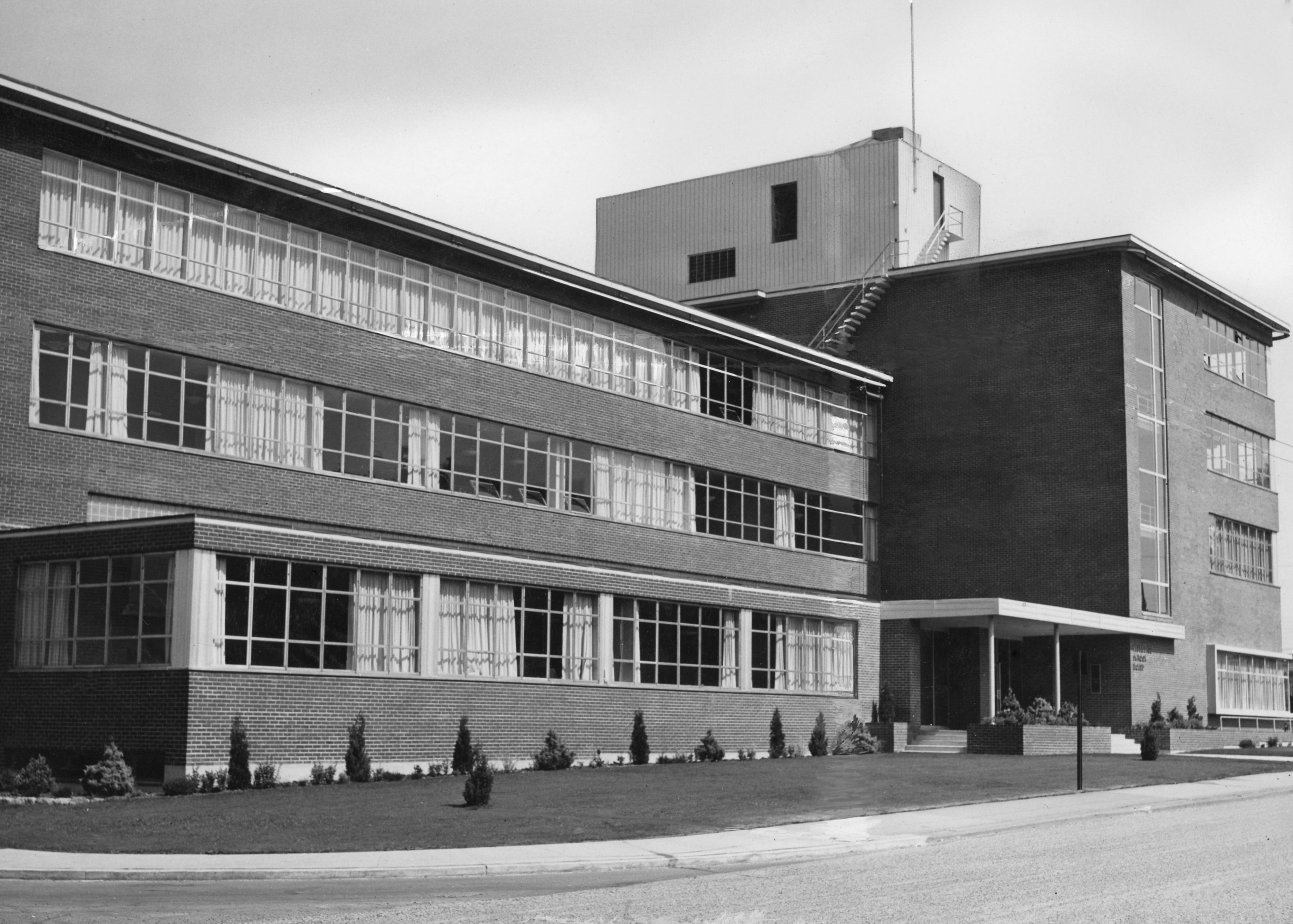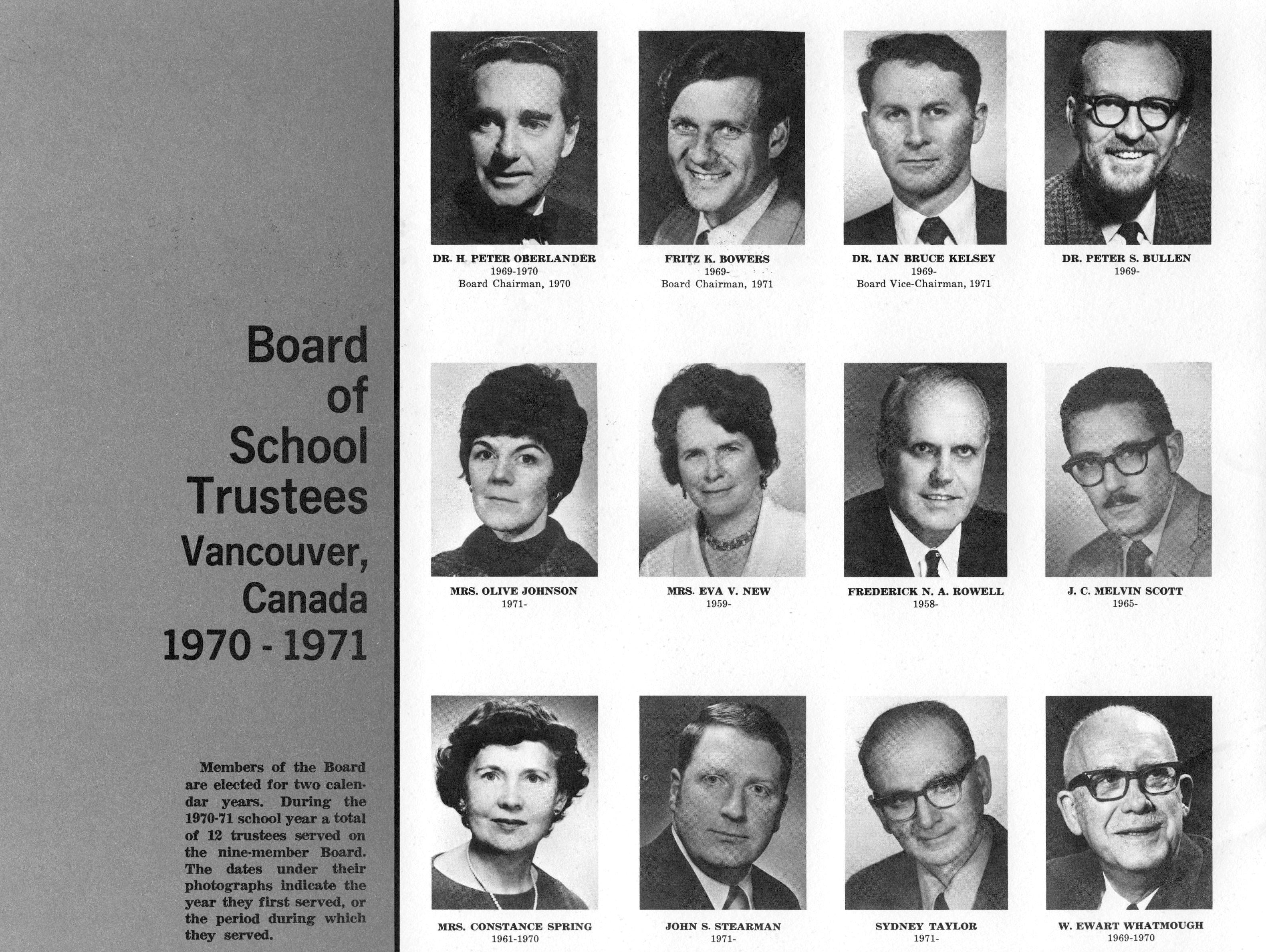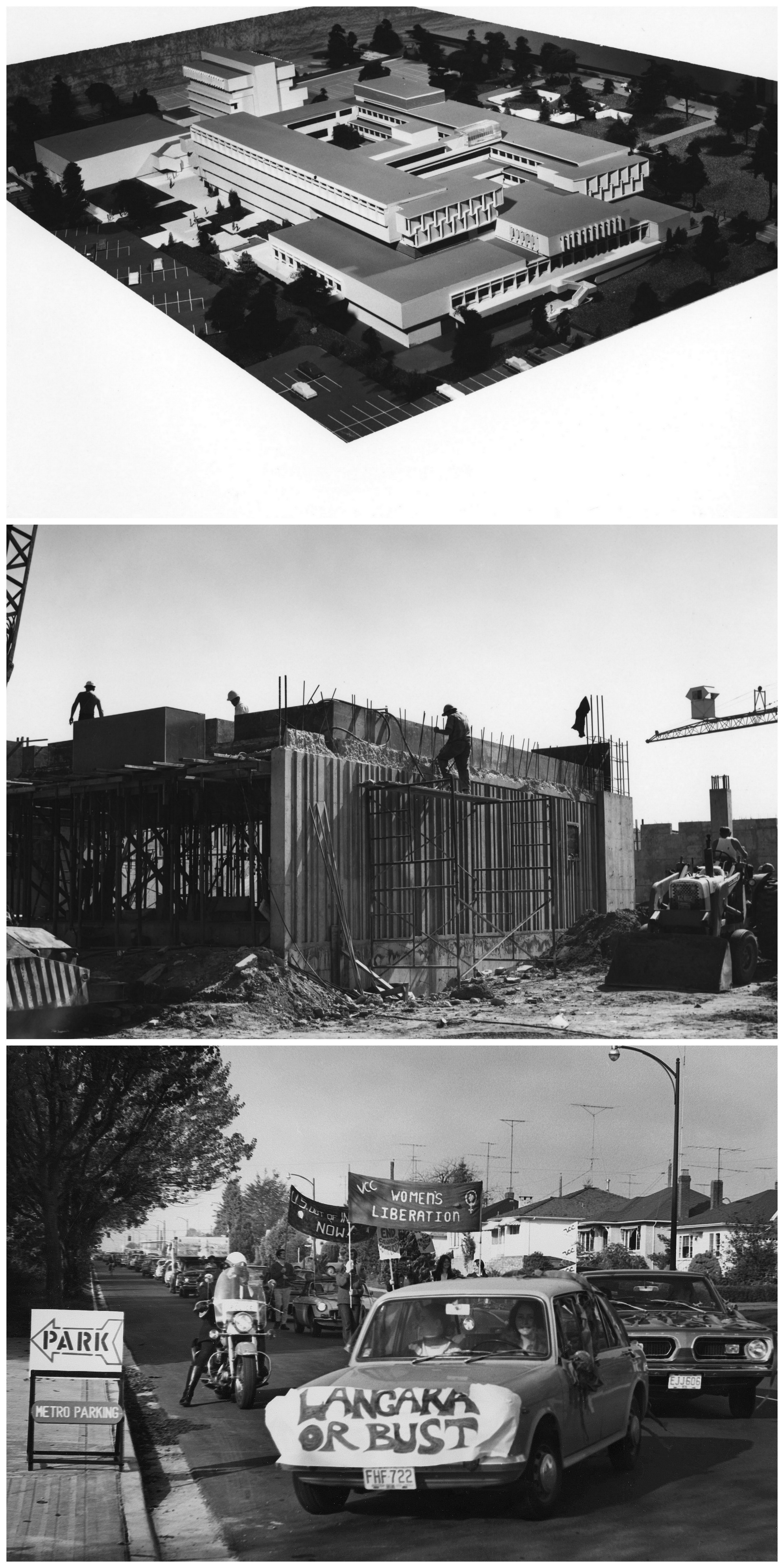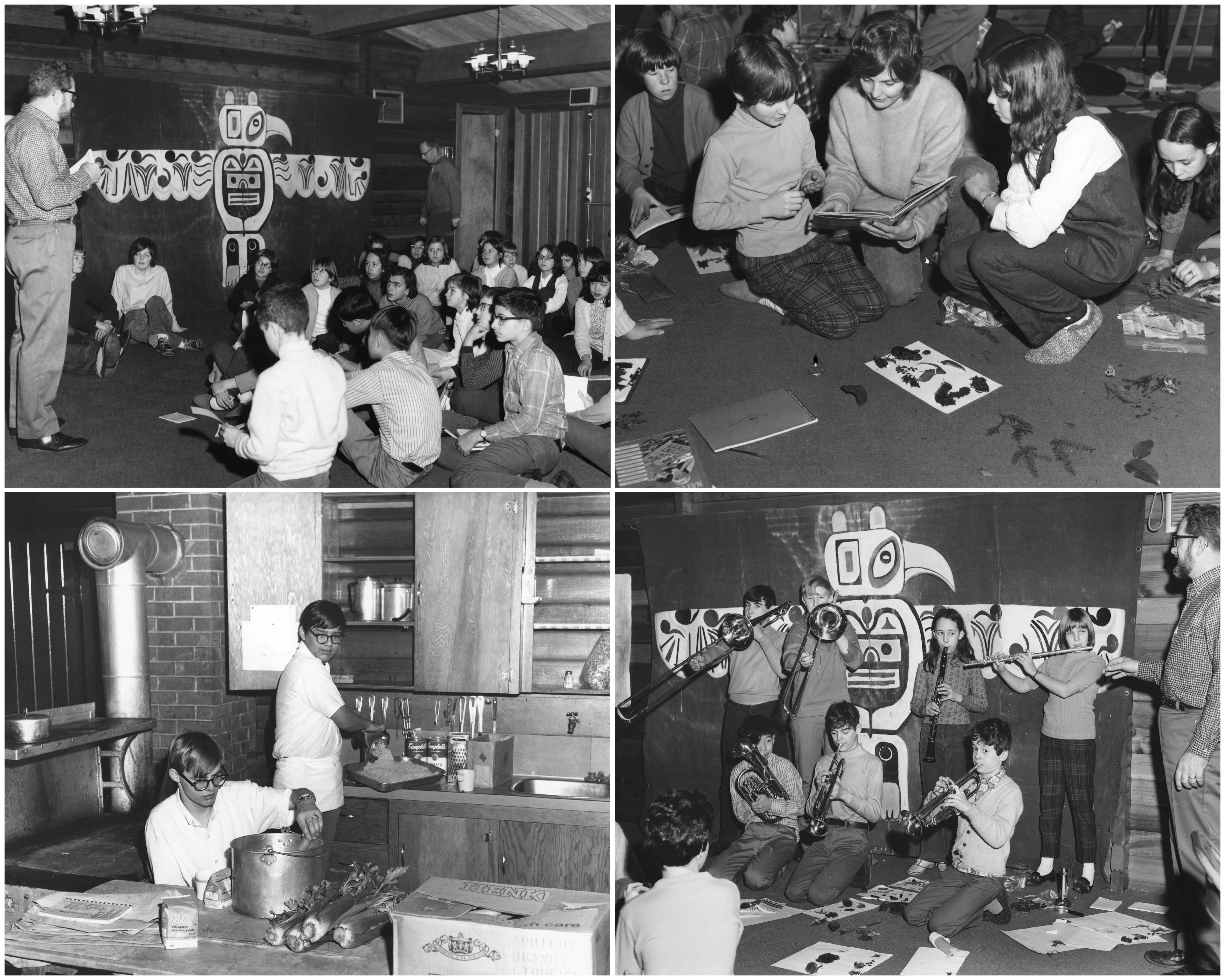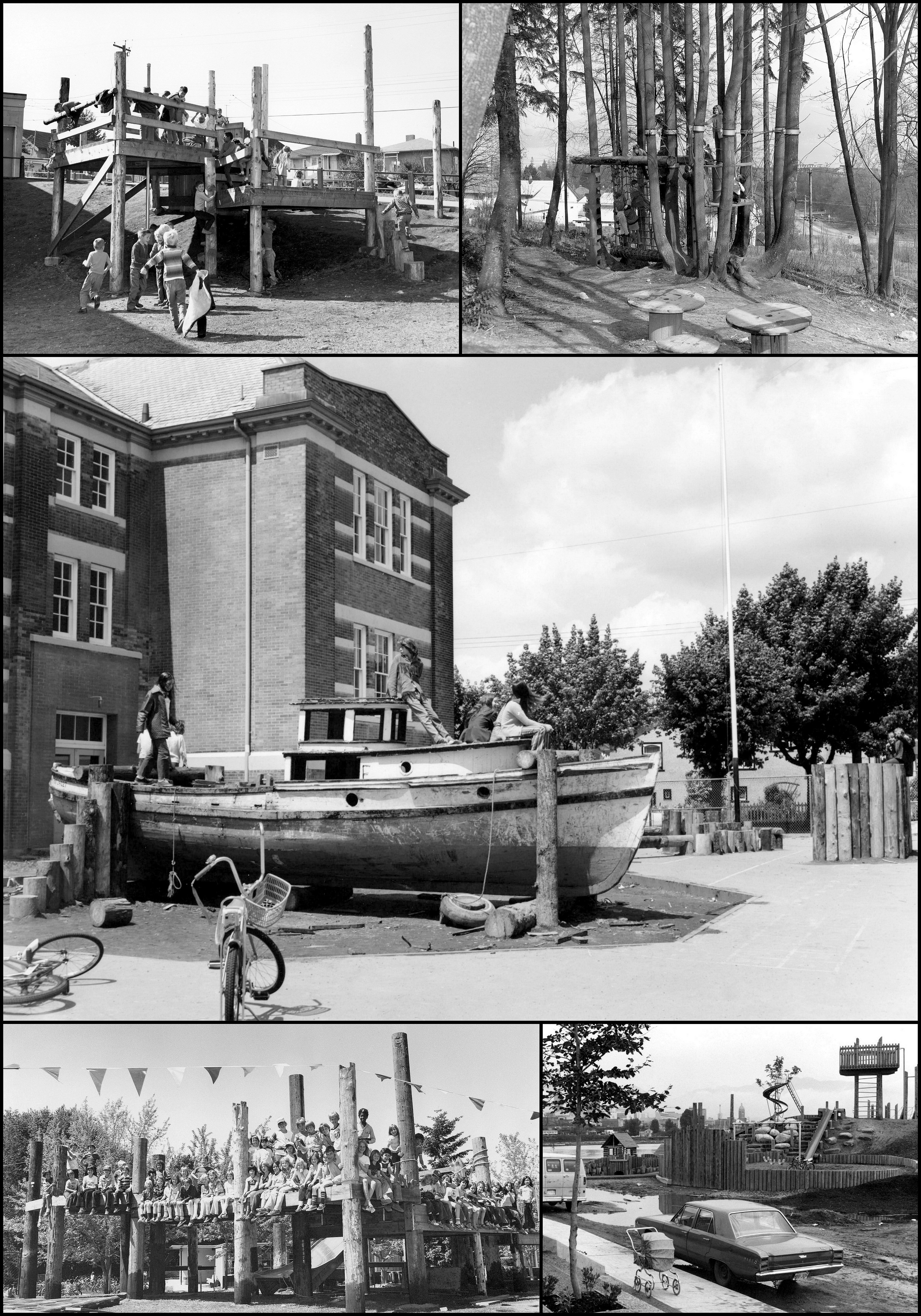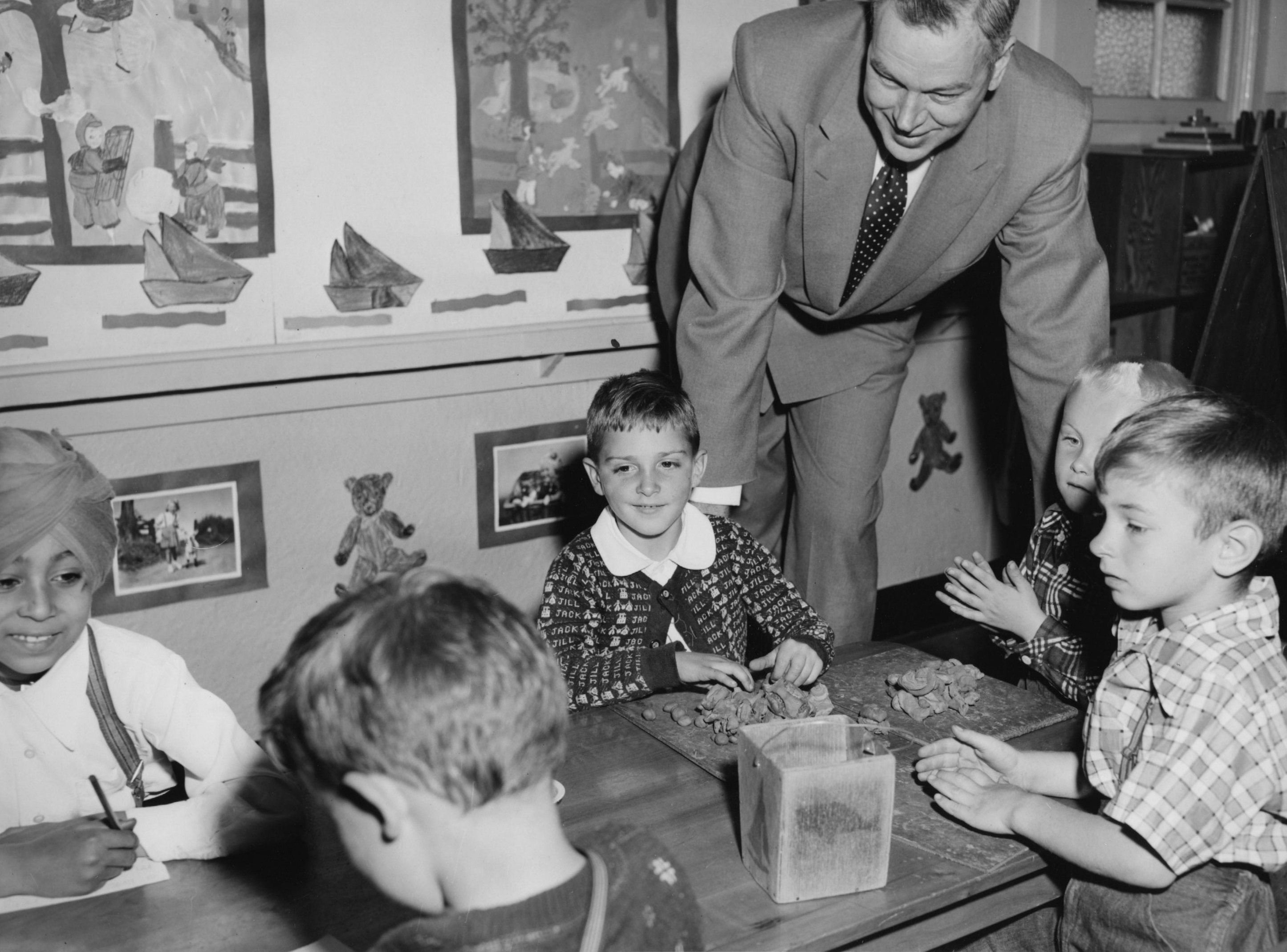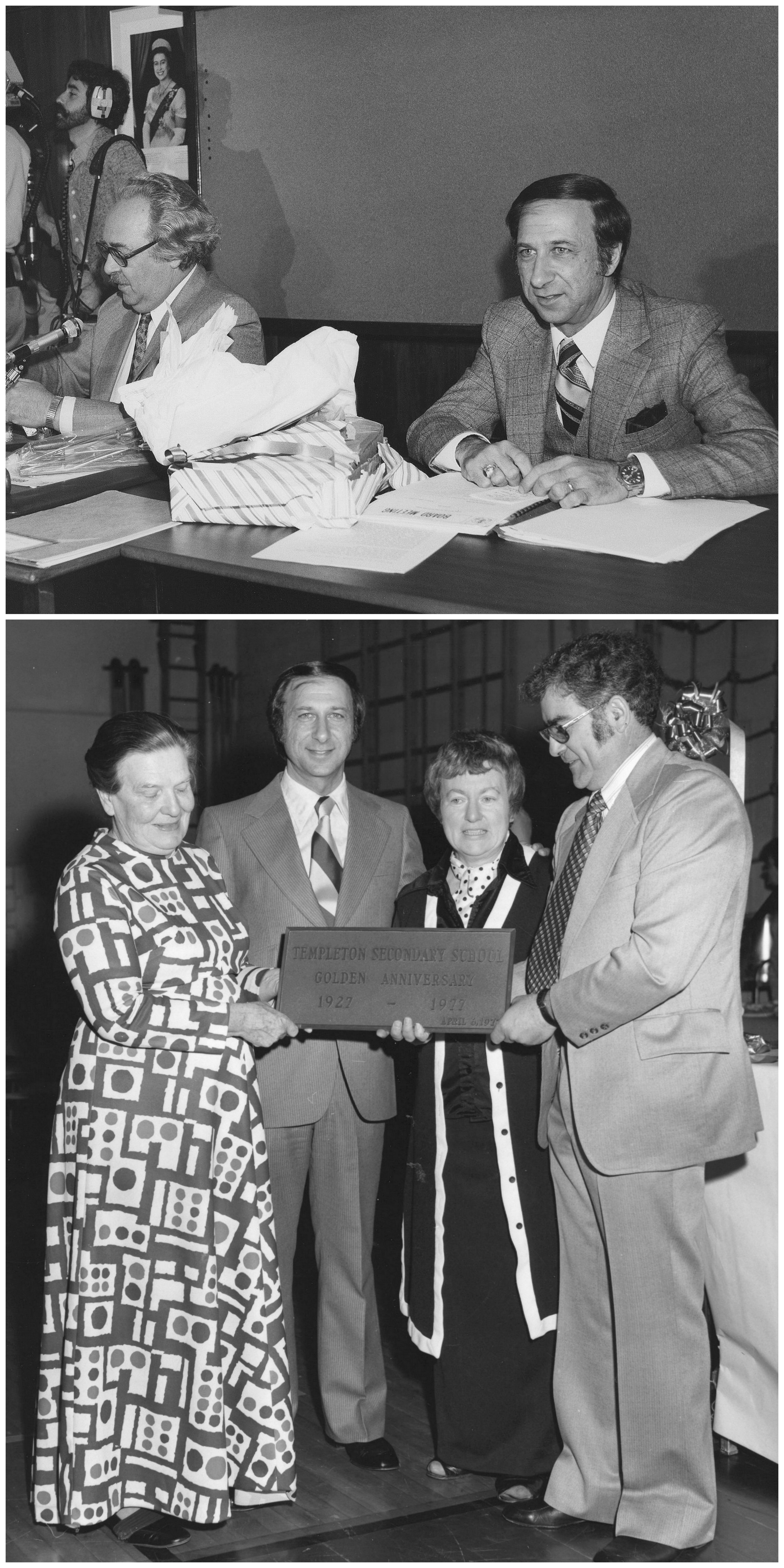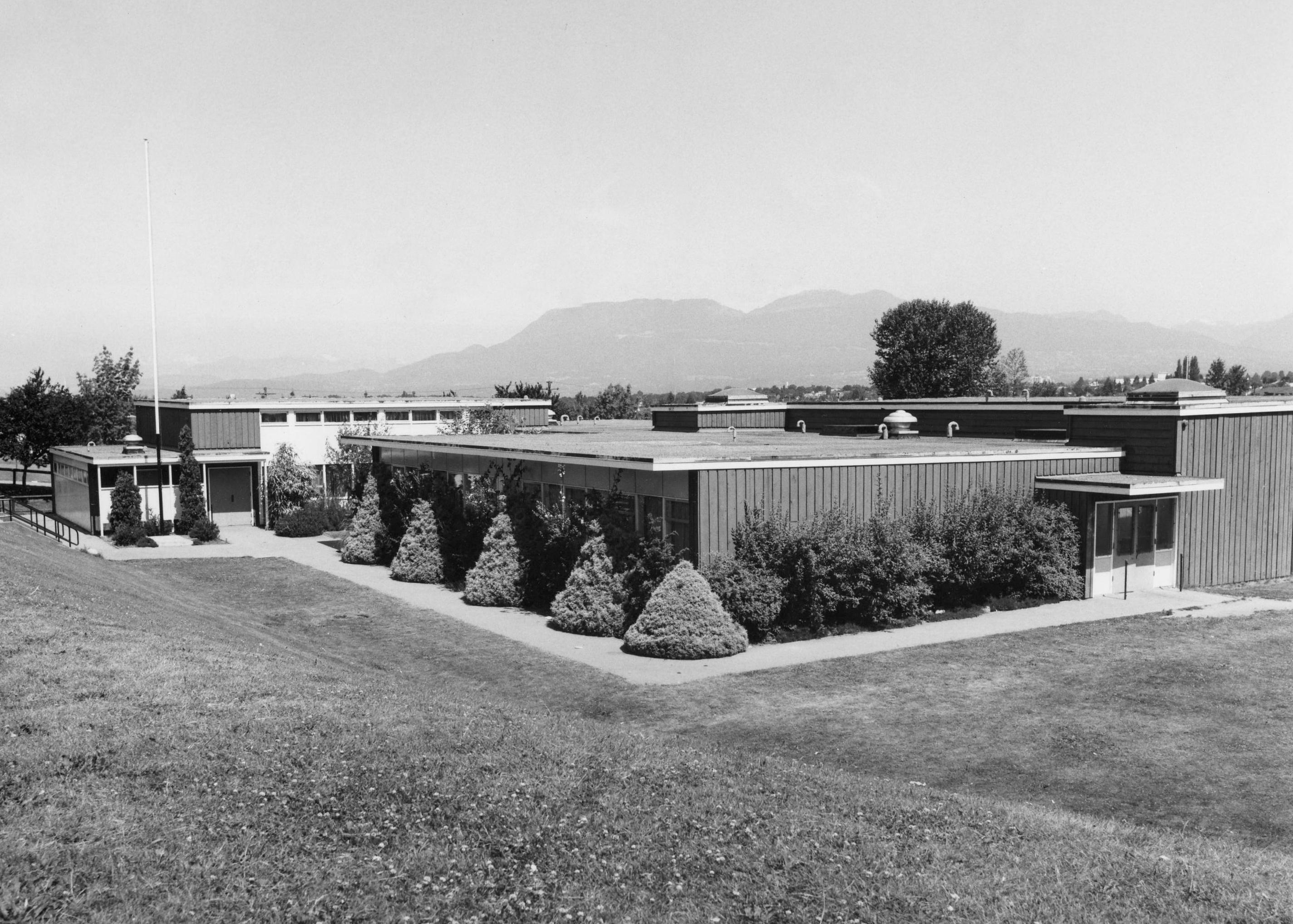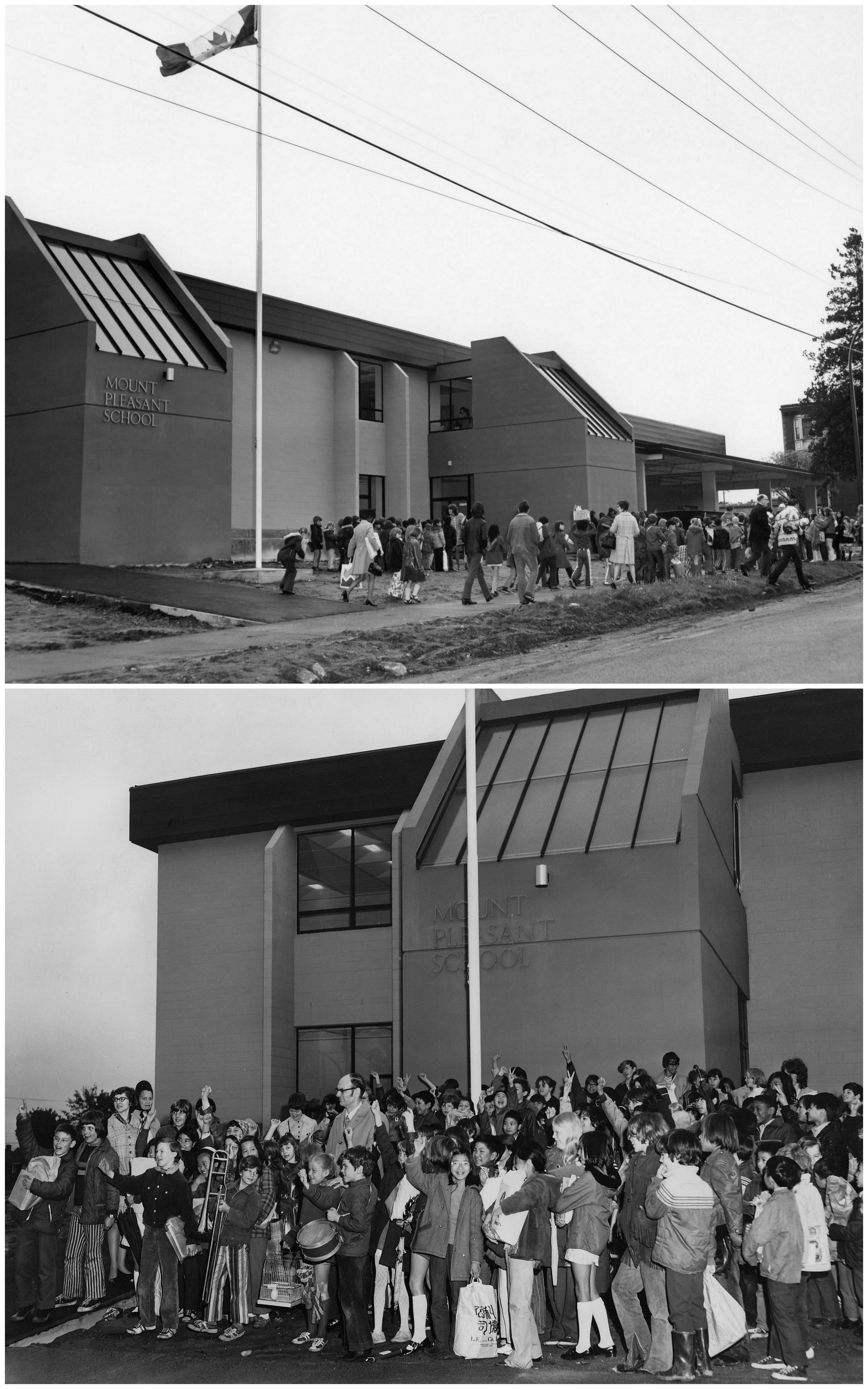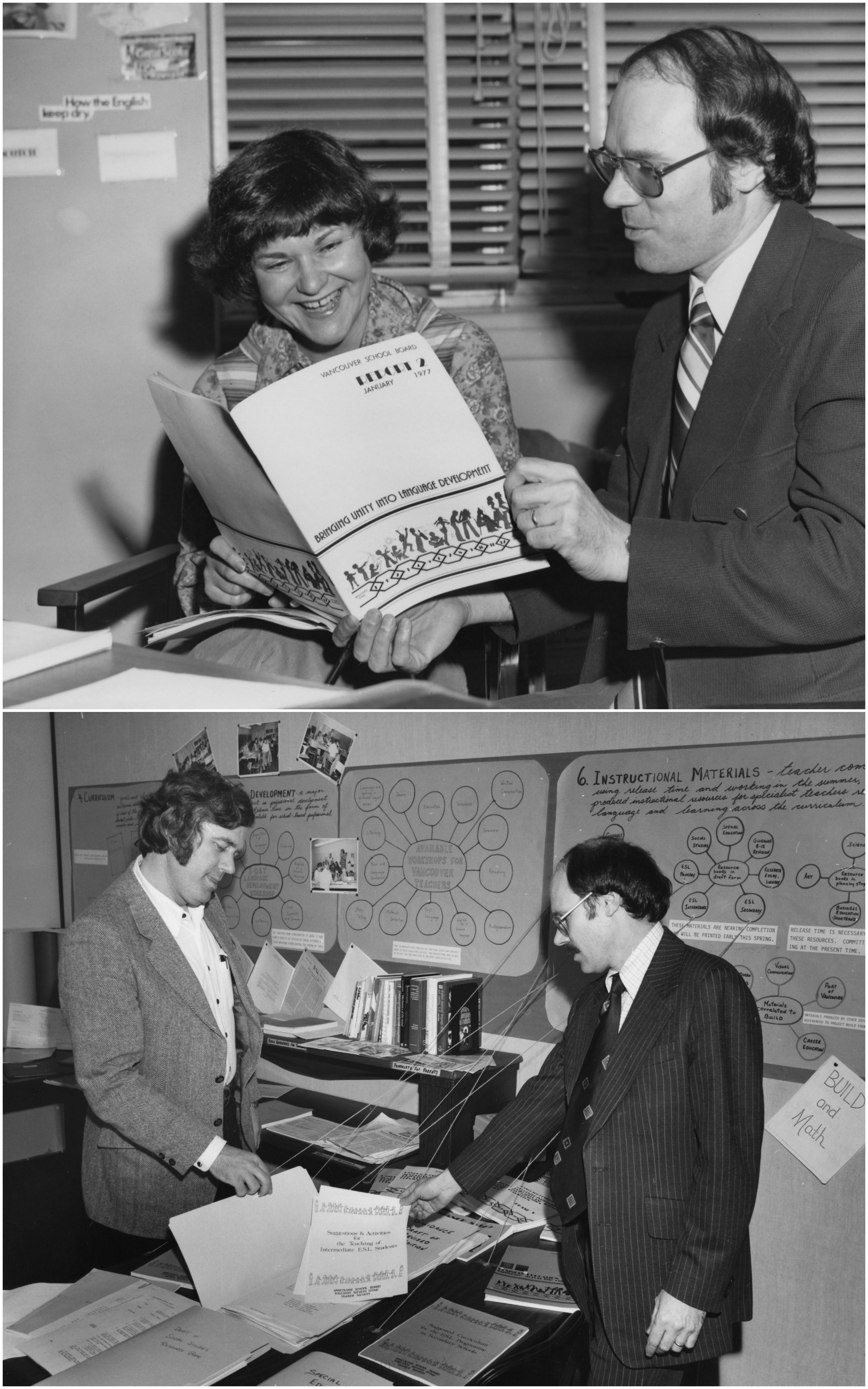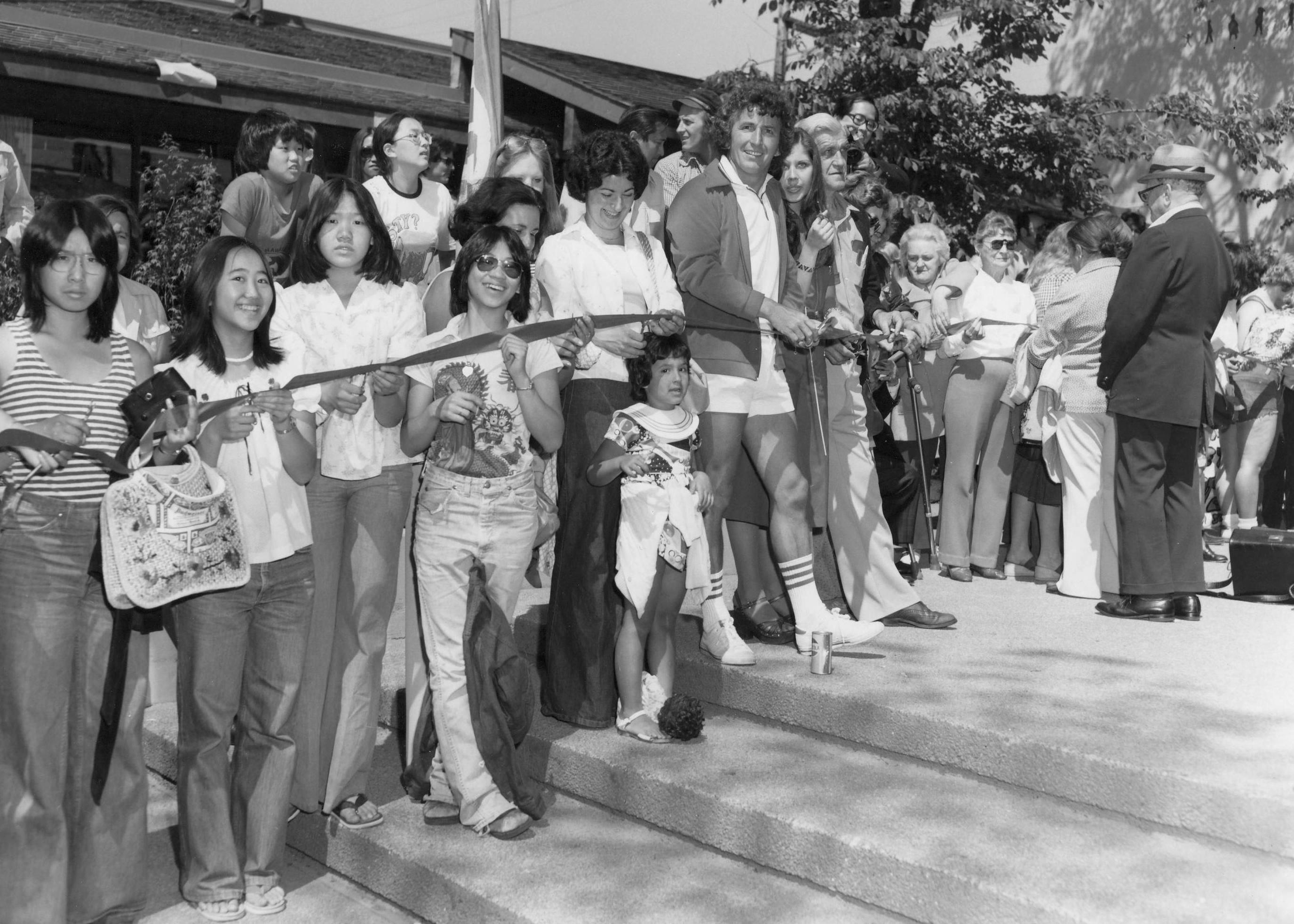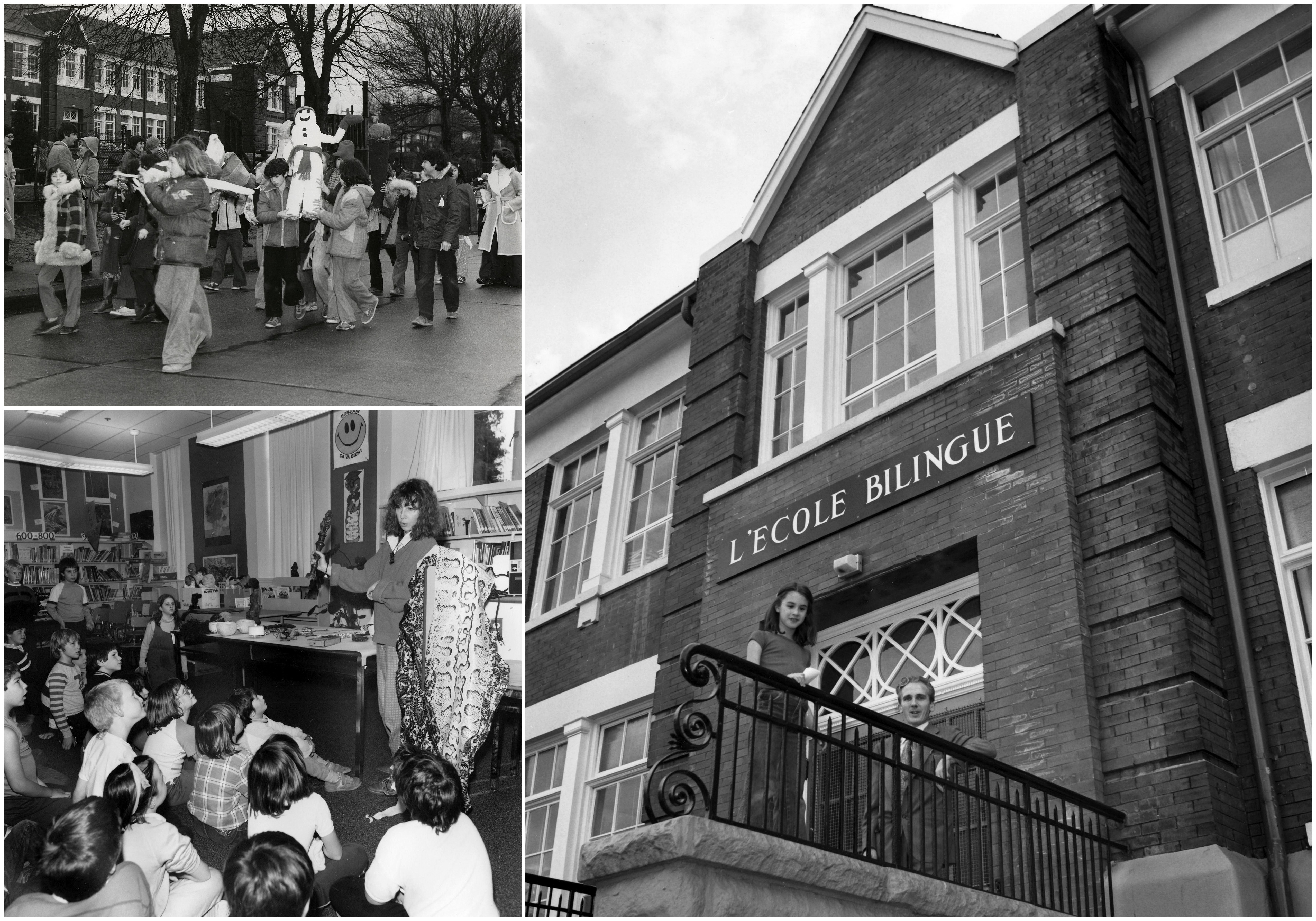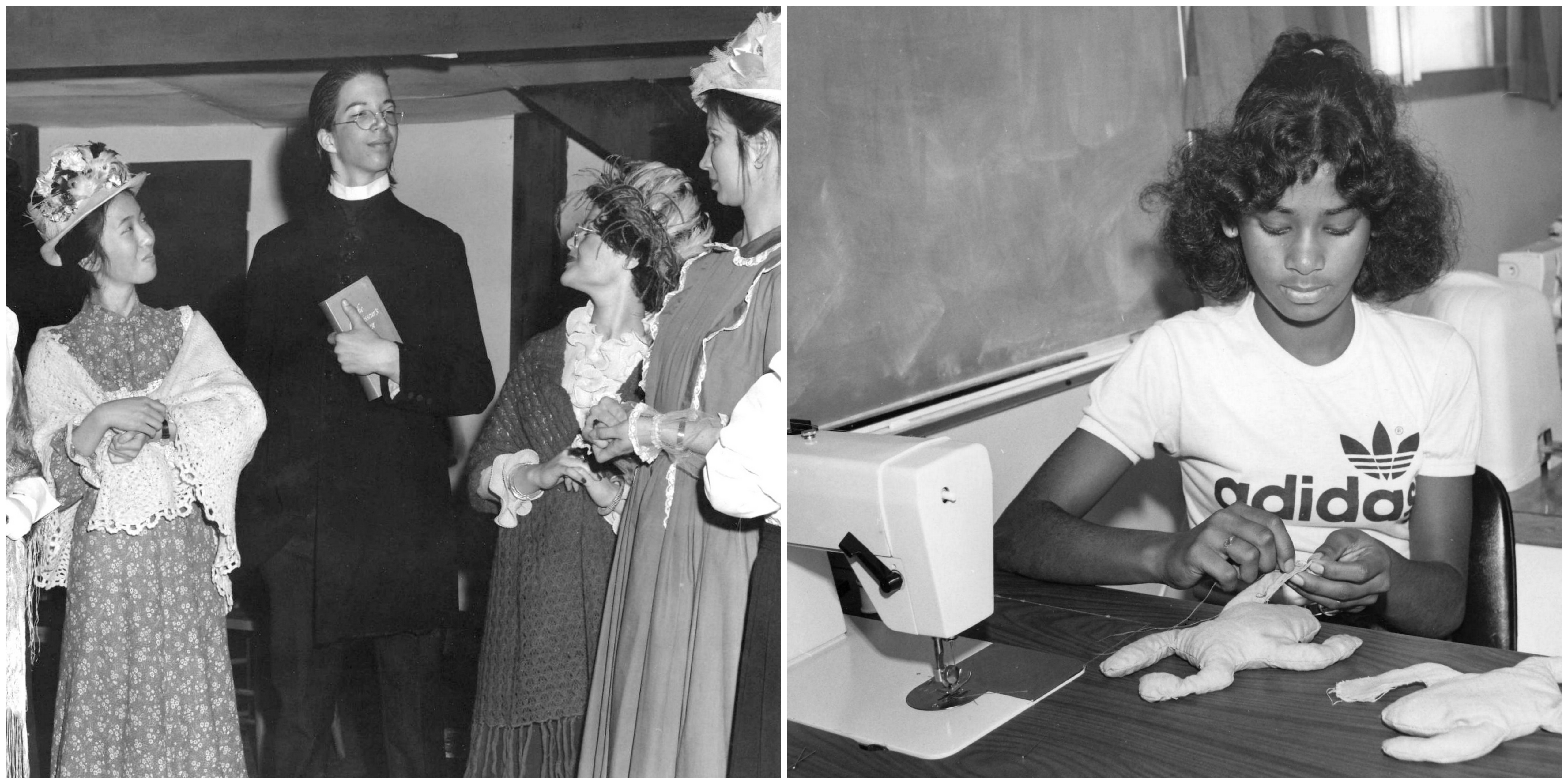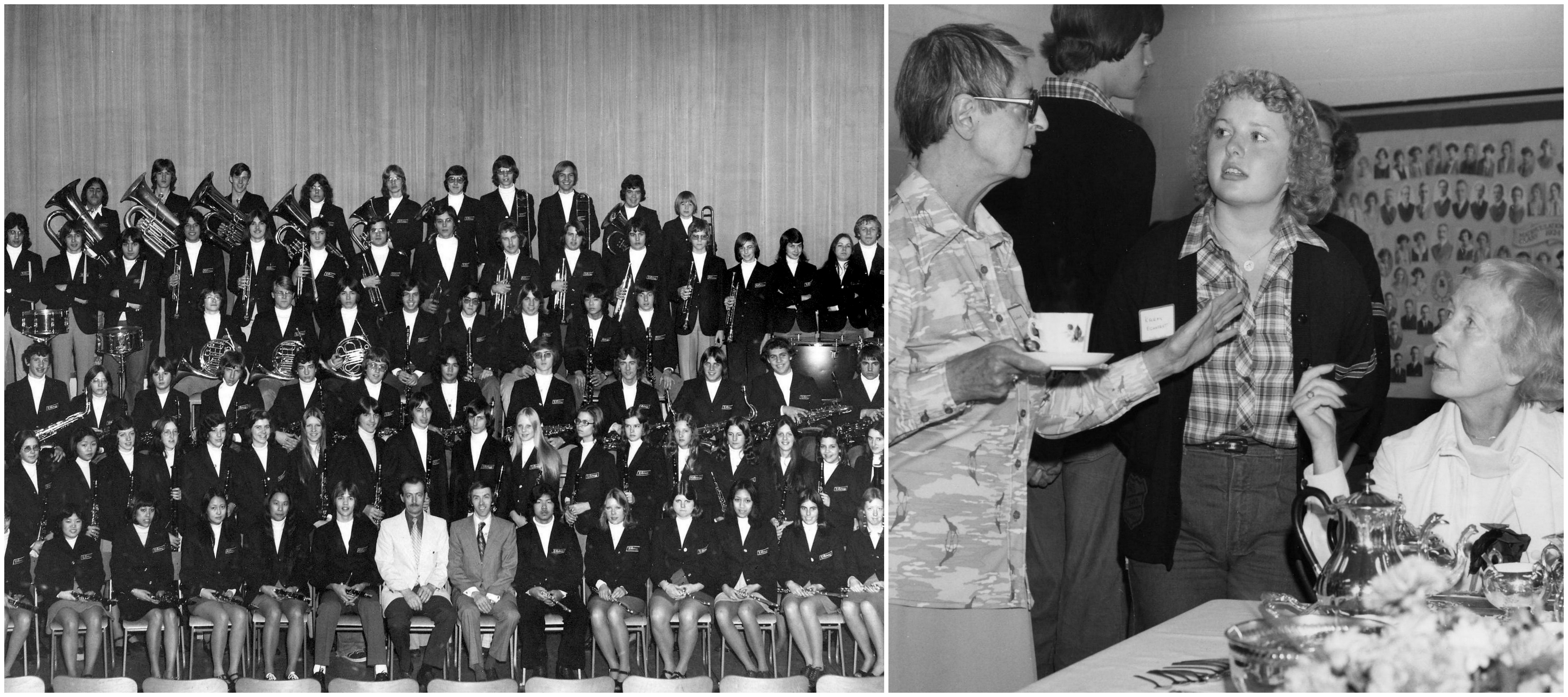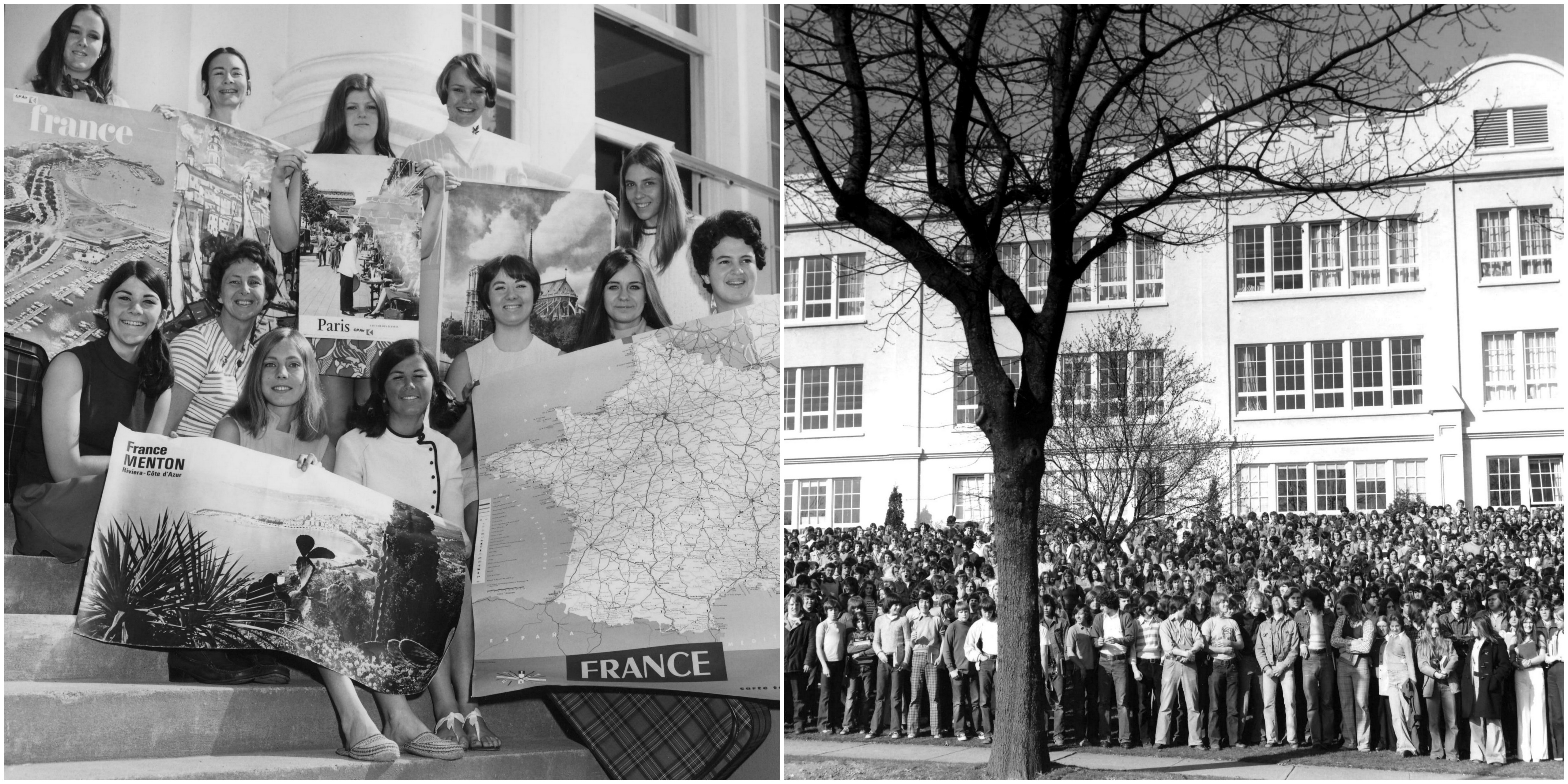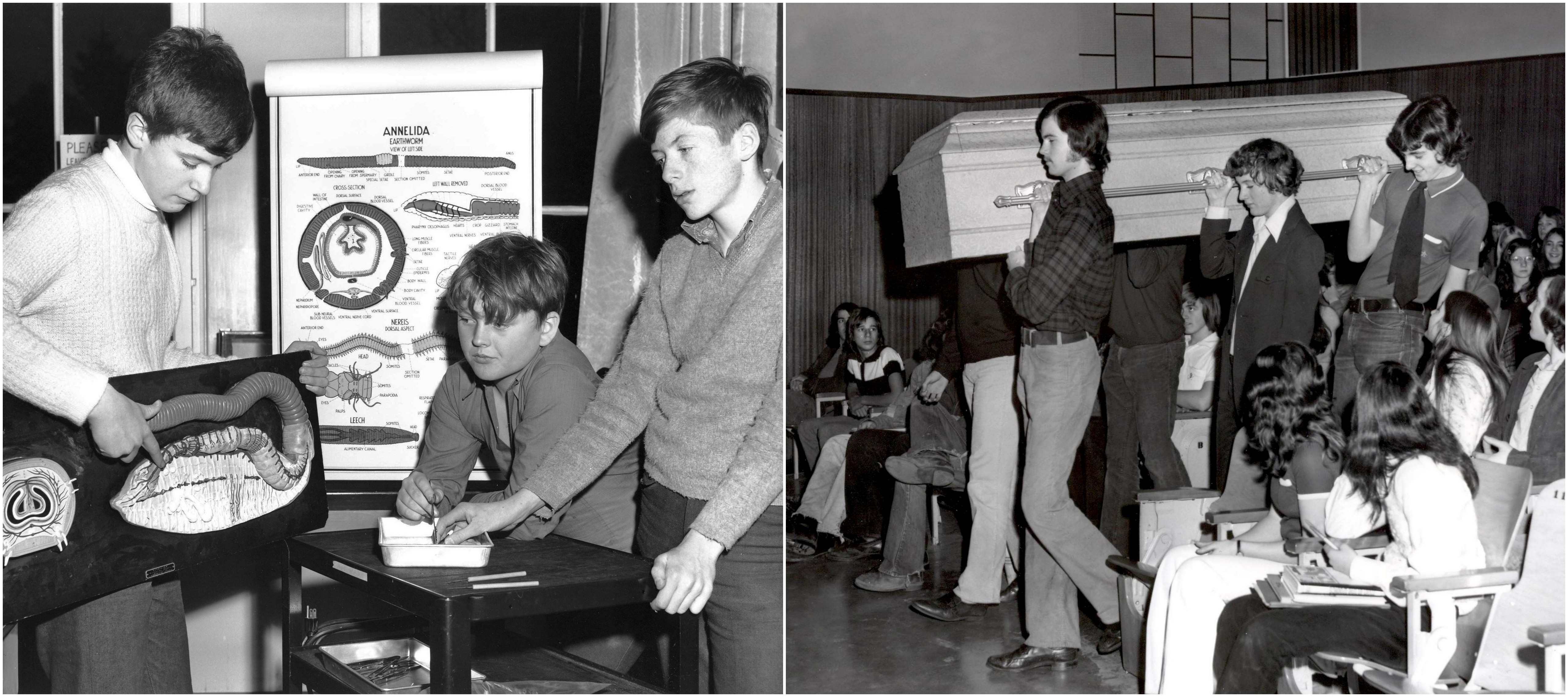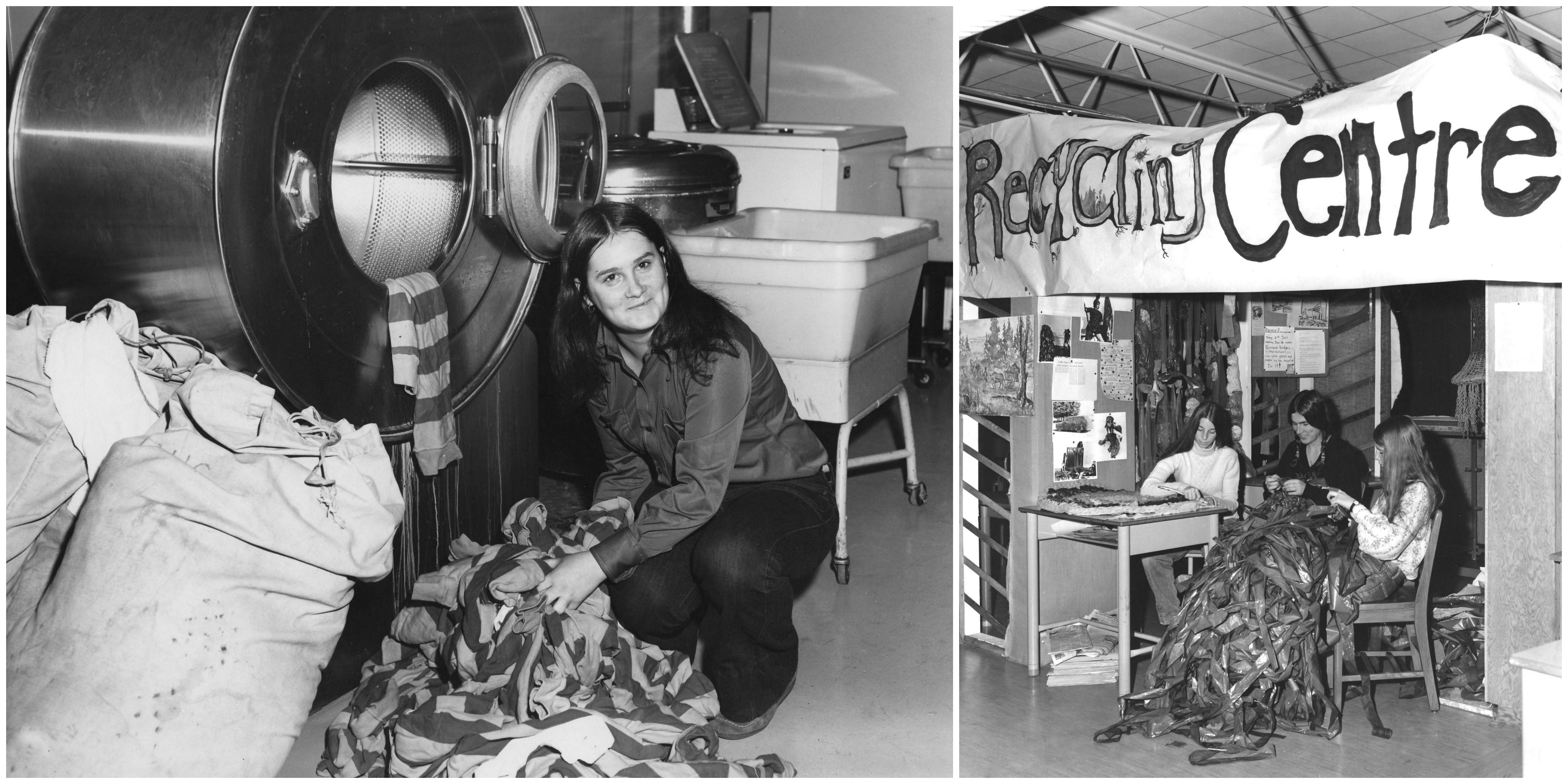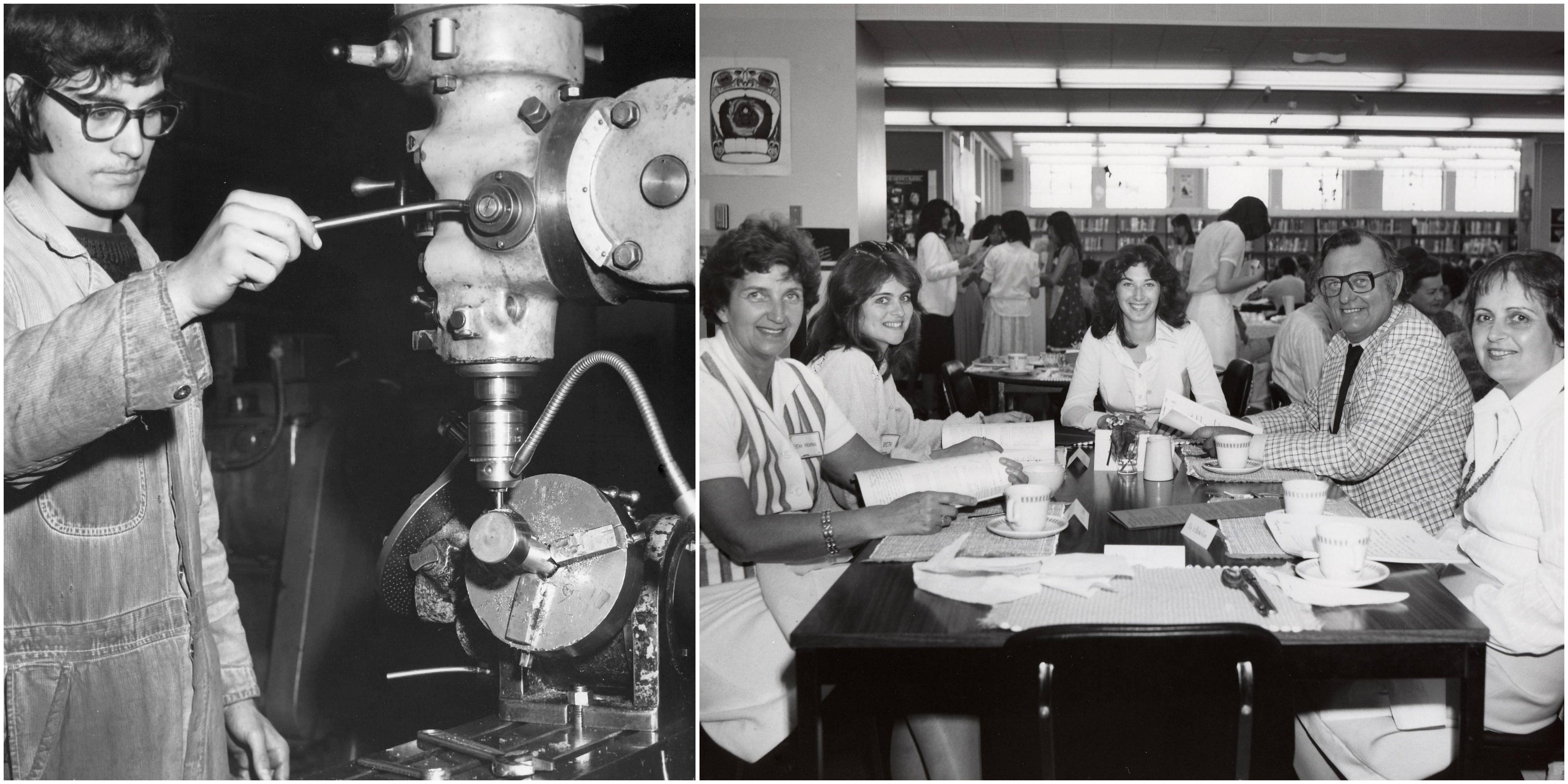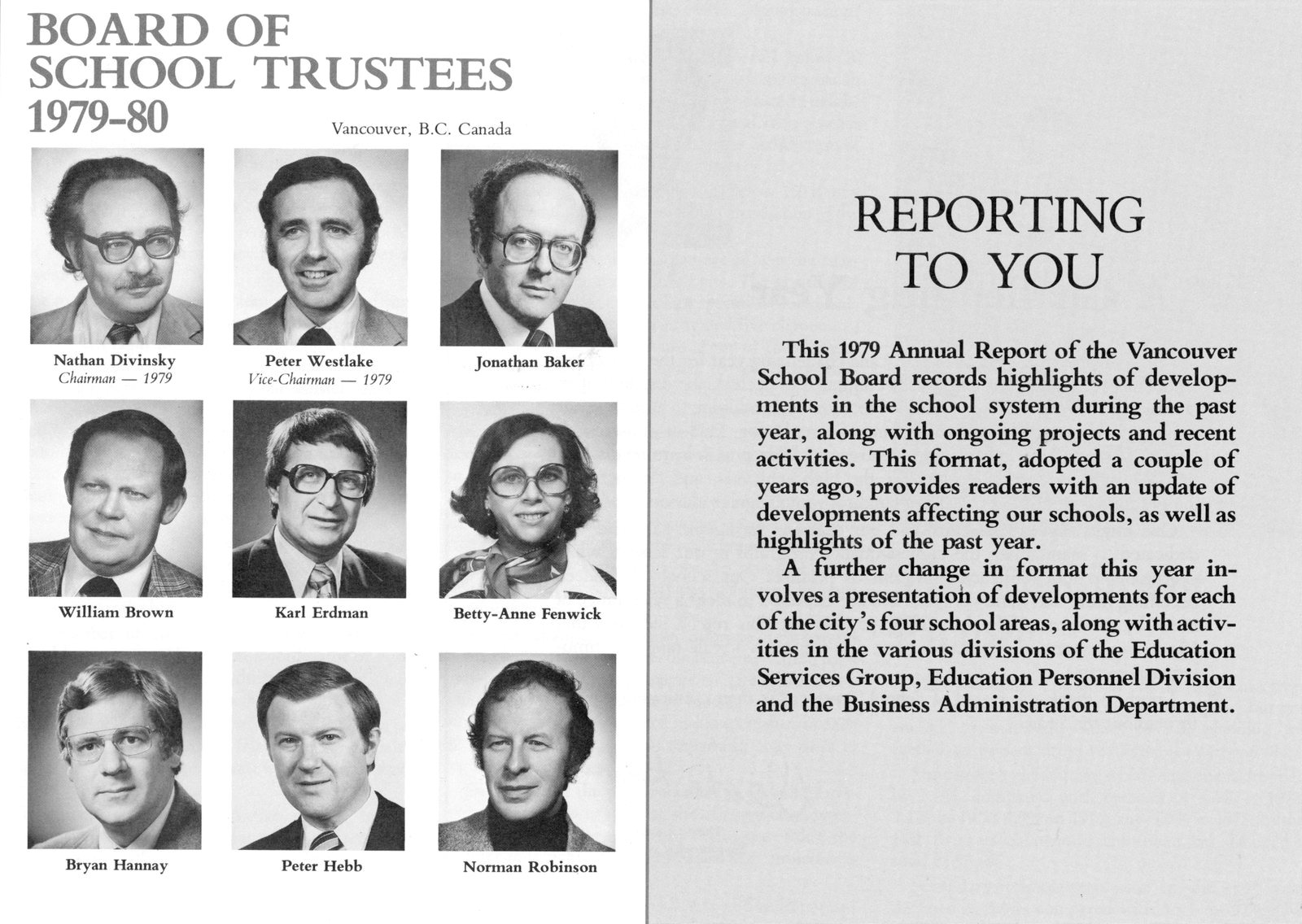Chapter Seven – The Seventies

Opening of the Britannia Community Services Centre, 1976
I. INTRODUCTION
Setting the stage – An outline of major events in the world, Canada, British Columbia, and Vancouver.
A. The World
1971 Idi Amin, a military officer, declares himself President of Uganda. A year later, he orders the expulsion of South Asian minorities.
1972 Relations between the United States and the People’s Republic of China improve following President Nixon’s visit there.
1973 Great Britain, Ireland, and Denmark enter the European Economic Community.
1974 Nixon resigns as President of the United States due to his complicity in the Watergate political scandal.
1975 The Vietnam War comes to a close. In the years that follow, more than one hundred thousand Vietnamese refugees are accepted into Canada.
1979 A period of improved relations between the United States and the Soviet Union ends with the Soviet invasion of Afghanistan.
Vietnamese refugees seek rescue following the victory of Communist forces in South Vietnam in 1975.
B. CANADA
September 1969 – The Official Languages Act of Canada comes into force. The Act gives French and English equal status in the Federal government and makes them “official” languages.
October 1970 – The FLQ (Front de libération du Québec) triggers the crisis on October 05, 1970 by kidnapping British trade commissioner James Cross. Five days later, the FLQ kidnaps Quebec’s Minister of Labour. Premier Robert Bourassa then petitions the federal government to invoke the War Measures Act. Prime Minister takes this action on October 16. The FLQ is banned and 500 suspected terrorists are arrested. James Cross is rescued but Pierre Laporte is found murdered.
December 1970 – The Royal Commission on the Status of Women releases a report that examines everything from access to abortion to the rights of Indigenous women. The report finds that housewives do an average of 77 hours a week of unpaid labour.
1971 – A policy of multiculturalism is officially adopted by the federal government led by Pierre Elliott Trudeau.
1973 – An international crisis triggered when the Organization of Arab Petroleum Exporting Countries proclaims an oil embargo spurs the development of Canada’s oil resources.
November 15, 2976 – The Party Quebecois, a separatist party led by Rene Levesque, wins the provincial election.
1977 – Canada adopts the metric system of weights and measures.
During much of the 1970s, “stagflation,” – a combination of stagnant economic growth and inflation – depresses the Canadian economy.
The FLQ Crisis (1970): Canadian troops guard streets in Ottawa, Prime Minister Pierre Trudeau talks to reporters prior to invoking the War Measures Act, the War Measures Act invoked.
Canadian Immigration Policies and Statistics during the 1970s
(Excerpts from A Hundred Years of Immigration to Canada 1900 – 1999)
1971 The federal government announces its policy of multiculturalism.
1971-72 The U.S. is the largest source country of immigration, in part because of the large numbers (possibly 30,000-40,000) of draft dodgers and deserters unwilling to fight in Vietnam who find refuge in Canada.
1972 By the end of 1973, more than 7,000 Ugandan refugees have arrived in Canada.
1978 A new Immigration Act comes into effect. Immigrants are divided into four categories: independents, family, assisted relatives and humanitarian. The Refugee Status Advisory Committee is created.
1979-80 60,000 refugees from Vietnam, Laos and Cambodia are resettled in Canada. In response to media reports of the plight of the “boatpeople”, thousands of Canadians join a private sponsorship program for refugees.
C. British Columbia
Milestones in Education during the 1970s
1970 Vancouver Community College’s Langara campus opens in October.
1972 The New Democratic Party wins election on 30 August. Eileen Elizabeth Dailly, MLA for Burnaby North and a former school teacher, is sworn in as Minister of Education on 15 September. The NDP government, led by Dave Barrett (a graduate of Britannia High School) remains in power from 1972 to 1975.
Premier elect Dave Barrett celebrates the NDP victory in the 1972 BC provincial election.
1976 February: corporal punishment (“the strap”) is abolished by an amendment to the Public School Act. June: departmental exams, i.e. province-wide Grade 12 graduation exams, are discontinued. The exams are reinstated in 1984. September: All school districts are required to make provisions for Kindergartens.
1977 The Social Credit Party, led by W. R. Bennett, wins election. Dr. Patrick McGeer is appointed Minister of Education.
1979 A “core curriculum” is established for provincial schools, from K – 12. The curriculum consists of three categories – “that which must be taught, that which should be taught, and that which may be taught.” The School Support (Independent) Act provides per-pupil funding for private schools that have been in operation for at least five years.
D. Vancouver
Aerial view of Vancouver – 1961
View from the Vancouver School Board building. Jan 17, 1969.
Two descriptions of Vancouver in the 1970s:
Vancouver in the ’70s: Grime, Gangs, and Protest – and Far Crazier Jesse Donaldson, 2 Nov 2016 | TheTyee
At the dawn of the 1970s, the City of Glass looked markedly different, and nowhere was that difference more obvious than the skyline. It would be decades before glass-walled high-rises came to dominate the downtown; in fact, it was only three years earlier that the 1967 Strata Titles Act had allowed for the creation of the condominium.
False Creek and Granville Island were cluttered with derelict warehouses. Sections of Robson Street were European-themed — Vancouver in the Seventies features photos of Danish tea rooms and schnitzel houses. Kitsilano — in particular a stretch of houses along West 4th Avenue known as “Acid Row” — was hippie central. Commercial Drive, Chapman explains, was still primarily Italian, and most businesses recognizable today had yet to take root (except for Nick’s Spaghetti House, which opened in 1955).
The 1970s: A decade that changed Vancouver forever VANCOUVER SUN, October 7, 2016
It was the decade of Greenpeace, when a ragtag group of Vancouverites banded together to launch a worldwide environmental movement.
It was the decade of street protests, when Vancouverites raised placards against the war in Vietnam, old-growth logging, nuclear testing, fluoride in drinking water and in support of workers’ rights, affordable housing, gender equality, aboriginal land claims and legalized marijuana.
It was the decade of the Gastown Riot and the Battle of Jericho but also the debut of Van Dusen Garden, The Naam restaurant, the NHL debut of the Vancouver Canucks and Fox and Fluevog’s funky footwear.
It was the decade that, indisputably, brought a seismic political, economic and cultural shift that would transform the picturesque one-time hardscrabble harbour town into a vibrant modern metropolis that would ultimately become an international model of urban density, green initiatives and ethnic diversity.
II. The Vancouver School Board
During the 1970s, the Vancouver School Board faced major challenges:
The challenge of declining student enrollment. In 1932, student enrolment in Vancouver public schools stood at 39,866. In 1970, it peaked at 75126. However, by 1977 it had declined to 61 920. The decline would have been greater but for increases in immigration of families from other countries to Vancouver.
The challenge of meeting the educational needs of a diverse student population. In addition to meeting the diverse needs of English speaking students, Vancouver public schools were providing services for more and more English as a Second Language students.
In 1975, a survey to identify ESL needs in the Vancouver School District revealed the following:
- English was the second language for 28.3 percent of all students.
- Of the total ESL students Chinese was the first language (42.7 %), followed by Italian (13.2 %), East Indian (9.0 %), and German (7.4 %).
The challenge of giving a voice to teachers, parents, students, and members of the general public on educational matters.
Paper presented by Dante Lupini, Superintendent of the Vancouver School Board at the Annual Joint Conference of the Alberta School Superintendents and the Alberta Education Management Society (Edmonton, Alberta, 1983).
One of the most significant changes influencing school board policy-making over the last dozen years has been the advent of politics. The advent of politics in educational organizations is best demonstrated by the emergence in the 1970s of interest groups. Schools and school boards have become highly targeted by such groups in part because of their high visibility and declining enrollment. In Canada, the 1970s were a decade of growing power in particular among teachers’ associations. As a result of the growth of interest groups, school boards have become highly politicized, and often party-affiliated. As previously routine matters have become increasingly controversial, superintendents have discovered that good decisions are based on an accurate perception of the power and goals of interests groups. With the politicization of school boards, and the increasingly nebulous line between policy and administration, the superintendent’s role now tends to be that of a negotiator designing proposals for maximum acceptability.
The challenge of promoting Canadian unity through educational initiatives such as French Immersion and Canadian Studies
These initiatives were prompted, in part, by the rise of the separatist movement in Quebec during the late 1960s and early 1970s.
A HISTORY OF THE VANCOUVER SCHOOL DISTRICT DURING THE 1970S
(as revealed in the Annual Reports of the Board of School Trustees.)
A. Annual Report for 1970 – 1971
Highlights:
1. Statement of the Aims of Public Education for the 70s:
Overall objective: To provide maximum opportunity for each student to develop his ability to live in this changing world in a way that gives him personal satisfaction and at the same time contributes to the positive growth of society.
Two general goals:
- To emphasize the personal worth of each student and help him develop a positive self-concept.
- To help each student develop competency in the basic and diverse skills essential to living in this world, particularly the skills to communicate, to use numbers, to think and to make decisions.
Guidelines for achieving the two goals:
- Matching the right students with the right teachers in flexible groupings.
- Developing a curriculum closely related to real life experience and allowing for the continuous ungraded development of each student. This necessitates providing options including learning in locations outside the school building.
- Identifying as early as possible students who need special assistance and providing it, as far as possible, through a learning assistance centre in the school.
- Bringing together those responsible for the learning experiences of students with resource persons who can contribute to those experiences.
- Encouraging teachers to use their professional freedom as set out in Board policy.
- Providing supportive services including consultative assistance and staff development programs that will help to achieve the goals
- Evaluating on a continuous basis what is being done in the schools in terms of these goals, considering both the cognitive and affective development of the students.
- Providing for community involvement in the schools through the associations of teachers, principals, and students with parents and other interested citizens.
2. Post-Secondary Education
Nov 30, 1970 – The Langara Campus of Vancouver City College opens. An independent College Council is named. It takes over operation of the college complex including the Langara campus, VVI, Vancouver School of Art, and the Special Programs Division. The Council is comprised of “five present trustees, to appointments of the Lieutenant Governor-in-Council, and the Superintendent of Schools appointed by the Minister of Education.”
The new Langara Campus of Vancouver City College.
3. Report of the Education Department
a) Schools used alternative ways to organize instructional programs:
- Semestering (Six secondary schools semestered all their courses in two five month terms and three others used a partial semestered plan.
- Modular scheduling (King George Secondary divided the week into 105 modules of twenty minutes, and students’ timetables were made up individually with variable numbers of modules.)
- Team teaching (a group of instructors work together to help a group of students learn) was practiced in open areas in a number of elementary and secondary schools.)
b) Students explored learning opportunities in their local community and in the city at large.
Britannia Secondary participated in Project Canada West which was assisted financially by the Canada Studies Foundation to explore different methods of conducting urban studies. Four Grade 11 classes used a variety of methods to collect information about and present solutions to problems they had identified in their community.
c) Educational Opportunities beyond the School District.
Activities included day field trips, extended field trips, and student exchanges. Examples: field trips to the local mountains, week-long visits to Camp Capilano, a week-long trip by a group of VSB students to Inuvik, and exchanges of VSB students with students from Northern BC;
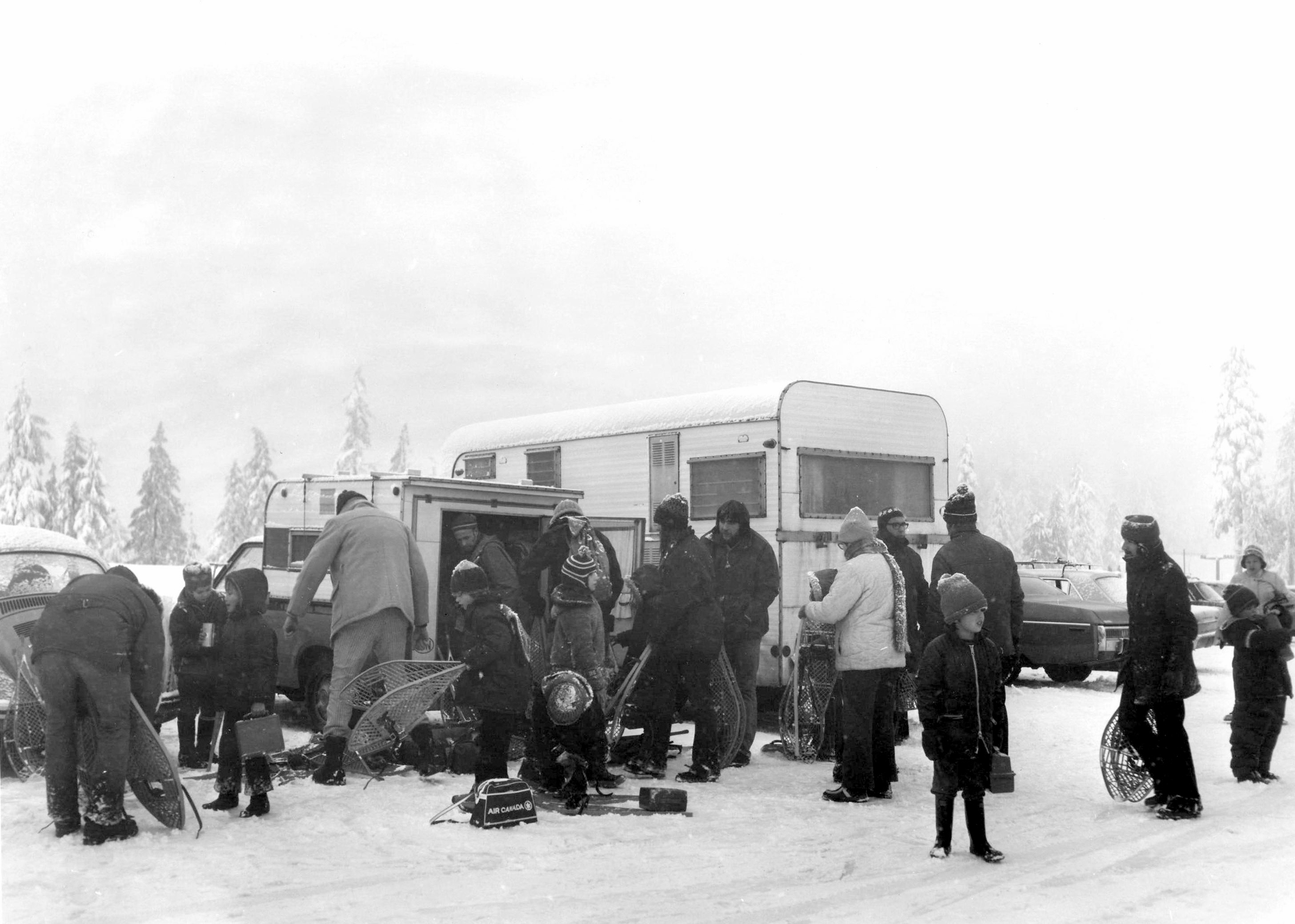 Pupils from Champlain Heights Elementary on a ‘snow shoe’ expedition at Cypress Bowl.
Pupils from Champlain Heights Elementary on a ‘snow shoe’ expedition at Cypress Bowl.
Vancouver elementary school pupils settle in for a week-long stay at Camp Capilano.
d) Parent groups helped to create adventure play areas. The parents raised funds and provided materials and labour at several elementary schools.
Examples of adventure play areas built in the Vancouver School District during the 1970s.
e) The number of auxiliary staff was increased:
- 76 staff assistants were employed in 18 high schools and 12 elementary schools.
- 162 part-time supervision aides employed in elementary schools.
- A total of 1474 volunteer aids (general public, university students, and secondary students assisted elementary schools.
f) Audio-Visual Resources
A major increase was made in the number of video tape recorders available to schools. Five TV cameras were also available for loan. Media Resource packages were supplied to all elementary schools. The packages included tape recorders, filmstrip projectors, OH projectors, and 8 mm film projectors.
Photo taken at Mount Pleasant Summer School, 1973
g) VSB Counselling Services (recommendations)
- Special counsellors – new role: area counsellors serving a number of schools, will maintain liaison with the secondary school in the area.
- School counsellors to be both generalists; each to be a resource person for the school team in one specific area.
h) VSB Special Education Services
- Learning assistance – support was given to the development of ‘Learning Assistance Centres’ to help “both handicapped children and regular class students with learning problems.”
- Remedial reading pilot program: at Point Grey Secondary, two groups of Grade 12 students met regularly with Grade 8 students to help them with reading problems.
FEATURE: TOTAL EDUCATION ALTERNATIVE PROGRAM
Two youth workers with the Anglican Church in Vancouver who were alarmed by a rapidly increasing drop-out rate in the city’s high schools started Total Education in 1970. Total Education taught these youngsters academically in small groups, and provided considerable counselling to them as well, with the aim of reintegrating them into the schools and society.
The youth workers incorporated their school privately under the Societies Act in 1971 on a shoestring budget and used volunteer teachers.
For the next several years Total Education took in young people that the public schools were failing to serve effectively. A significant number came from high-poverty areas on Vancouver’s east side, and quite a few were teenagers were living on their own. Seeing the need for the services Total Education offered, the Vancouver School Board absorbed the school into the public system a few years after it opened.
Follow this link to learn more about the Total Education:
TOTAL EDUCATION Alternate Program
…………………………………………..
B. Annual Report for 1971 – 72
Highlights
1. Establishment of a Kindergarten to Grade 12 (K – 12) Organization.
The goal: to provide for better coordination between secondary schools and their associated elementary schools.
2. Establishment of Learning Assistance Centres in Schools.
The District’s 24 special counsellors were re-assigned as area counsellors, each serving a number of elementary schools. Their mission: to team with school personnel (principal, teachers, and school nurse) to establish Learning Assistance Centres in each of their schools. The goal: to allow the quick identification and treatment of children with learning disabilities and to reduce the number of special classes in schools.
4. Establishment of Library Resource Centres in Schools
The goal: to transform school libraries into Library Resource Centres that provide a broader range of learning materials and learning activities. A survey showed that a total of 23 elementary and 11 secondary schools met the standard for library resource centres.
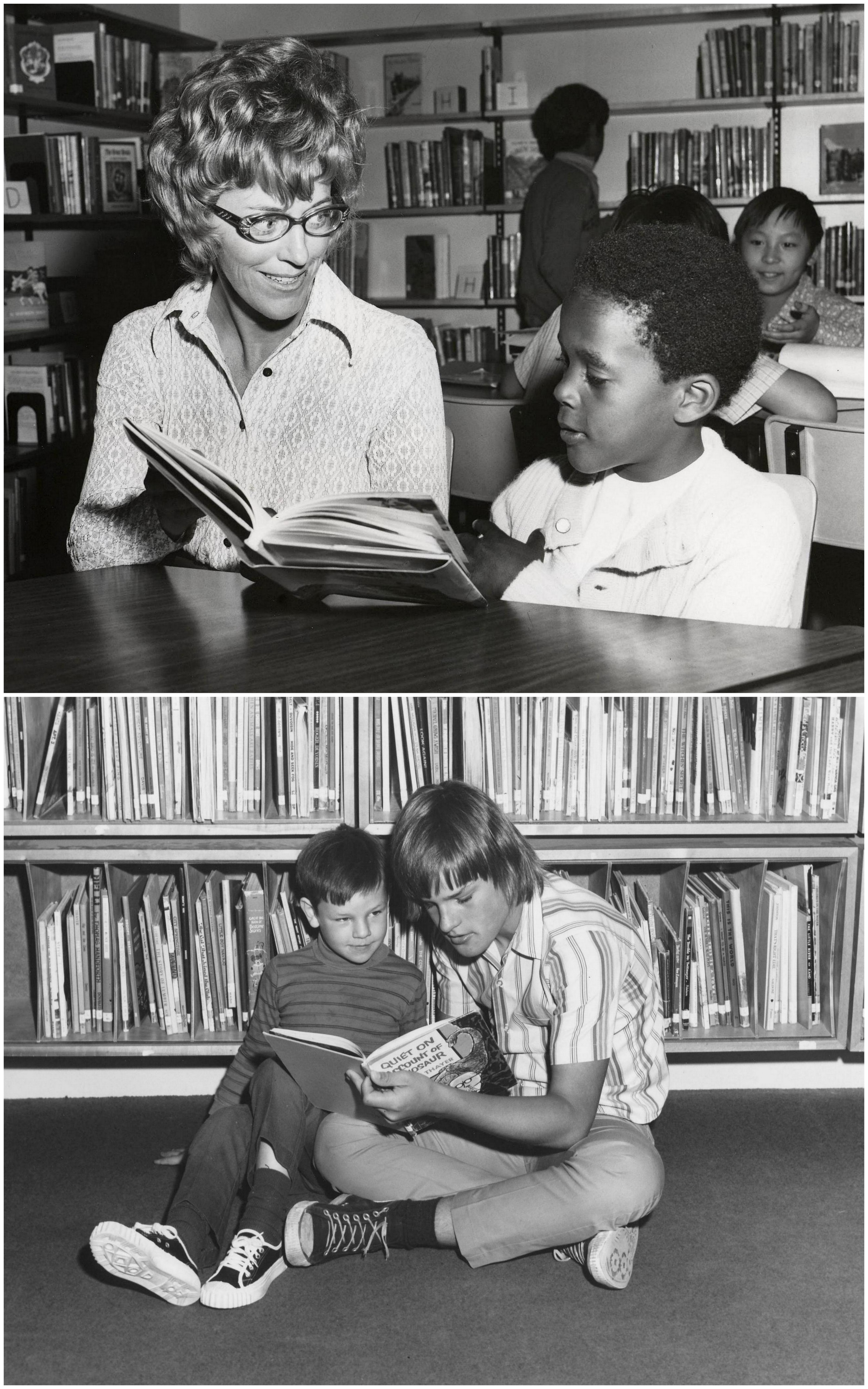 Lord Selkirk Library Resource Centre
Lord Selkirk Library Resource Centre
5. District Audio Visual Resources
Bookings of audio-visual aids totalled 102,133 – a 16.7 percent increase over the previous year. The biggest single increase was in video tape bookings, which recorded an 88 percent gain.
6. Increase in Auxiliary Staff
The number of aides increased by 42 percent. The total of 2093 aides consisted of:
- 1088 from the general public,
- 430 college and community college students
- 575 secondary students.
7. Looking Ahead: Community School Committees.
A major development was the creation of a plan to establish community-school committees. The Board approved recommendations to divide the school district into 18 regions each determined by a secondary school and its associated elementary schools to encourage the establishment of a committee in each region. These committees could include principals, teachers, secondary students, parents and other citizens, non-teaching school staff, and the liaison trustee.
9. Community Education Services
The night school program was reorganized under a new title – Community Education Services. This reflected the joint involvement of the Vancouver School Board and the newly appointed Vancouver City College Council.
FEATURE – CITY SCHOOL
In 1970, the Director of Instruction for secondary schools in Vancouver was Alfred Clinton. He wrote “A Proposal for an Ungraded Continuous Progress School (City School)” and in it referenced the Metropolitan Learning Centre in Portland, Oregon as well as the now extinct Parkway Program in Philadelphia as “similar projects.
Dr. Clinton’s vision closely paralleled the project based learning methods now being adopted by innovative educators in many schools.“This approach will be radically different from that practised in conventional classrooms… For example, rather than engaging in systematic study of the various disciplines, the student will focus on the solution of problems more relevant to his needs.” Rules and regulations would be few: “Students will be asked to work together congenially, to follow agreed procedures of daily accountability in developing and working out their individual programs, to record and evaluate their learning experience and to attend on a regular basis.”
As per Dr. Clinton’s proposal, City School opened its first set of doors at 550 West 10th Avenue on September 7, 1971.Some ninety students were enrolled in Grades 4 to 10 in the initial year, with a faculty of four teachers and a staff assistant.
Marilyn J. Reid studied the progress of this education experiment in its first year and reported to the Vancouver Board of School Trustees, “At the core of City School is the involvement on an equal (in most instances) basis of everyone, students and teachers alike. Students have votes of equal status in matters of policy, organization, discipline and rules. This ‘democracy’ extends to the choice of subjects offered. If a student wants to pursue a particular interest with other students and staff, he is expected to initiate the activity himself.
(Source: article posted on Wikipedia)
………………………………………
C. Report for 1972 – 73
Highlights:
1. Statement on Teacher Autonomy
The Board of School Trustees continued to hold its position that alternatives should be provided, that the teacher is the professional and must have the freedom to decide the appropriate teaching strategies, and that the school and its community are inseparable.
2. Expansion of Alternative Programs
- Three alternative schools – Total Ed, City School, and University Hill Secondary School – operated for a second year.
- Several new alternative programs were launched. Three were operated jointly by an outside agency and the Vancouver School Board (The 7A Program, 8J9J, The Vinery Project.) The others were conducted by other agencies with School Board assistance (Outreach School, Operation Step-up.)
- Ideal School was established in 1972 by teacher Garry Nixon, formerly of St. George’s School. He intended to be an independent, alternative high school. In 1974 the school approached the Vancouver School Board for economic support. Once absorbed by the Vancouver School Board, the tuition was removed and teacher salaries were increased.
Follow this link to learn more about the 8J9J Alternative Program:
Class 8J-9J at Britannia Secondary
3) Key Developments – ELEMENTARY
Several schools expanded connections with their local community.
- The main local school-community experience to date has been gained at Strathcona and Thunderbird elementary schools. Building additions including community facilities were officially opened at Thunderbird in November 1972 and at Strathcona the following month. Both schools organized new community programs and expanded existing ones.

 Two photos: ‘Opportunities for Youth Program at Strathcona Elementary (1972)
Two photos: ‘Opportunities for Youth Program at Strathcona Elementary (1972)
- A major step forward in linking schools with their communities was the organization of the city’s first two community schools. – Bayview Elementary and Champlain Heights Elementary (opening in September 1973.) Community committees will participate in both projects in an advisory capacity for policy, programs and functions of the community school and for assessment of community needs and priorities for those needs.
Champlain Heights Community School
The Vancouver School Board provided for another form of community use of schools by:
- amending rental regulations to provide that when school facilities are vacant on school days, they may be made available at no cost to licensed non-profit day-care organizations
- ensuring that all new Vancouver school construction include facilities for pre-school, full day-care and after-school care programs as needed.
Changing to metric.
Plans were made to teach Vancouver’s primary pupils to measure in metric units, as a first step to prepare them for Canada’s change to the metric system.
4) Key Developments – SECONDARY
A recent increase in the number of high school dropouts had raised concern.
Proposed remedies:
- Increase the number of locally developed courses approved by the Department of Education. Action: 14 new courses were offered this year. Another 10 were approved by the Department of Education for the 1973-74 school year.
- Improve the Grade 7-8 articulation process. Recommendations: give Grade 7 pupils more opportunities to visit the secondary school before they enter it.; keep parents informed about aspects of secondary social life that cause them concern; devise methods to notify Grade 8 teachers about pupils who may have difficulty adjusting to secondary school.
5. OTHER DEVELOPMENTS
a) Family Life Education – attention was given to identifying what topics should be included in family life education and how it should be presented to students and parents. Possible topics: birth control, self understanding, sexuality, dating, marriage, and effective parenthood. Pilot programs were conducted in a number of secondary schools.
b) Community-Police Liaison – a pilot project was carried out at Killarney Secondary and its community of elementary schools. Its aim: to improve relations between young people and the police. It was made clear to participants that law enforcement played no role in the project.
The pilot project proved the value of assigning ‘police liaison officers’ to schools and consequently, police liaison officers were posted to John Oliver Secondary and Lord Byng Secondary in the spring of 1973.
The Board also asked the Police Department to assign three more officers in the 1973-74 school year – to Vancouver Technical, Thompson, and Gladstone – and a fourth to be shared by King George and Kitsilano.
c) Teacher Professional Development – a ‘Teacher Centre’ was established in a former elementary school annex. During the school year, most of the workshops, seminars, and in-service activities offered to District personnel were conducted at the Teacher Centre. The Teacher Centre also hosted meetings of teachers and administrators and displays of learning materials.
Teacher Centre – Workshop on teaching the metric system.
d) Summer School – a greater focus on ‘general interest’ programs:
Dr. Robert F. Sharp looks back (excerpt from his final report)
As Superintendent of Schools for the past 18 years, I have written the introduction to each Annual Report. This is the last report that will include my comments as I shall retire before the next year is published…
The Board approved “Educational goals for the ‘70’s”, which took into account the views expressed by trustees, principals, teachers, and students and the results of innovations in Vancouver and in other school systems. At this time, progress was being made in the introduction of alternative programs, the integrated day in primary classrooms, multi-age groupings, and learning assistance centres.
During the past 1971 – 72 year, the major problems resulted from the Provincial Government’s action in reducing from ten to eight percent the amount by which operating expenses could exceed the cost of the basic education program as determined by the Government. The defeat of the $961, 313 operating referendum for the additional amount between the eight and ten percent forced the Board to make substantial cutbacks; the hiring of a large number of replacement teachers was cancelled, a substantial amount of equipment replacement was deferred, and fund for substitute teachers was reduced.
On the credit side of the ledger there has been the success of the Planning and Evaluation Department in planning school-community facilities. School Board and civic officials held many evening meetings with citizens to plan accommodation suited to community use. Five school-community projects were in various stages of development, the most comprehensive being the Britannia Community Services Centre.
Dr. Robert F. Sharp served the Vancouver school system for 47 years as a teacher, administrator, inspector, Assistant Superintendent, and Superintendent.
……………………………………….
D. Report for 1973-74
Highlights:
Dr Dante Lupini begins his first year as Superintendent. (Previously, Dr. Lupini was a regional director with the Montreal Catholic School System. He was fluent in English, French and Italian.)
1. Canadian Studies Project
This project was launched with the establishment of an ad hoc committee of teachers and university, college, and Board representatives who were asked to produce a program with greater emphasis on Canadian Studies in the Social Studies 10 and 11 curriculum. Project “associates” included four department heads and 17 other teachers.
The objectives of the project associates were to develop leaching and learning strategies and materials that would help students understand Canada, its background, and its similarities to and differences from other countries, and give them a positive attitude about being Canadians. The impetus for the project came in part from the rise of an independence movement in Quebec beginning in the 1960s.
2. Expansion of Alternative Education
The Vancouver School board substantially expanded its alternative education program by incorporating into the public school system programs previously operated outside the Vancouver system. The following is a list of all Vancouver School Board alternative programs operating during the 1973-74 school year:
- Chimo Place
- The Vinery
- The Bridge
- L’Ecole Bilingue
- Prince of Wales Mini School
- University Hill Secondary
- City School
- Operation Step-Up
- The 7A Program
- The 8J9J Program
- Total Education
- Outreach School
- Ideal School
Follow this link to learn more about the beginnings of alternate education in Vancouver:
The Rise of Alternative Education in the Vancouver School District
3. Teacher Professional Development
During the school year, a total of 248 workshops, courses, and seminars were conducted in the regular professional development program, a 48 percent increase over the previous year. The Teacher Centre continued to be the major location for professional development meetings.
4. Computer Education Services
A more effective computer education service was provided with the installation of a Hewlett-Packard computer at John Oliver Secondary and of terminals at 15 secondary schools linked by telephone line to the computer.
5. Progress on Library Resource Centres
Under the library modernization program started five years ago, 51 of the 70 elementary and 14 of the 18 secondary schools now had up-to-date library resource centres.
6. Learning Assistance Centres
The number of elementary schools with full-time learning assistance centres expanded dramatically, from 20 with full-time centres to 39. The rapidly increasing number of students with a non-English speaking background posed a major challenge in a number of elementary schools. One result: practically all the time in their learning assistance centres was devoted to support in language arts.
7. An experimental mobile workshop built in the summer of 1973 was stationed during the year at six elementary schools where almost 50 boys and girls learned to use wood and metal hand tools.
8. Prince of Wales Mini School
Prince of Wales Mini School was a district enrichment program offered by the Vancouver School Board. The Mini School was established in 1973 by Dr. Len Drugge, an innovative public school science teacher looking to create a new kind of high school experience.
Prince of Wales Mini School
Dr. Drugge envisioned a small school community where each student brings his or her unique contributions and has a strong voice in guiding their own learning. Dr. Drugge’s vision for PW Mini School has been a model for high school enrichment programs throughout BC.
Featured Photos: Mount Pleasant pupils trek to their new school building
……………………………………………….
E. Report for 1974-75
Highlights:
1. Re-organization of the Vancouver School District
The reorganization reduced the number of areas in the school system from seven to five, each under the supervision of an area superintendent directly responsible to the Superintendent.
The area assistant superintendents moved their headquarters out of the central office and into their areas. This new arrangement has increased the opportunities for broader participation in educational decision making.
The re-organization at the same time has created a channel for understanding community expectations from the schools, by providing locally-based education offices where frequent face-to-face interaction with parents and other citizens occurs.
2. ESL Pilot Project
The plans for the 1975-76 ESL pilot project included establishment of eight ESL classes and nine English Learning Centres (ELC’s) in 12 elementary schools and five ESL’s in four secondary schools.
3. Status of Women
The report submitted by the Vancouver Elementary School Teachers Association included recommendations on the following matters:
- male-female teacher rations
- appointment of women to administrative positions
- use of the title Ms.
- part time teachers
- Women’s Studies
- integrating elementary playgrounds
- family life courses
- sex stereotyping
The report of the Vancouver Secondary Teachers Association made recommendations on the following matters:
- appointment of women to administrative positions including department headships
- orientation for potential administrators
- part time teachers
- integration of staff rooms
- maternity leave
- parenthood leave for teachers of either sex
4. More liaison officers
- The School Liaison Program was expanded to cover half the secondary schools and their associated elementary schools in the Vancouver School District
- A considerable amount of each officer’s time is devoted to dealing with problems of individual students, in cooperation with counsellors, teachers, principals and parents.
5. Alternative Education
B.C. Quest, an alternative program of wilderness education at Prince of Wales Secondary School, was expanded to include students from three other secondary schools. Students divided their time between the classroom and wilderness activities including mountaineering canoeing, and cross country skiing.
6. Student trip to China
Twenty secondary students participated in an 18-day tour of China. They were accompanied by a VSB trustee, and assistant superintendent, and two teachers. Upon their return, the students made a documentary film of the trip with the assistance of technicians from the Canadian Broadcasting Corporation.
7. Indigenous Home and School Workers
Three workers were appointed to assist Indigenous children. They were assigned to Southlands, Seymour, and Strathcona elementary schools. They assisted teachers, facilitated communication between the students’ parents and the schools, and provided liaison with government agencies.
8.Community Education Services
This organization, formerly a joint operation of the Vancouver School Board and Vancouver Community College was divided into two sections, operated by the Board and the College respectively. The Board’s CES expanded its operations to include the following: evening and daytime general interest courses, summer school, mothers’ and pre-schoolers’ programs, and a tutor referral service.
…………………………………………………
F. Report for 1976
Highlights:
1. The steady decline in overall enrolment – a condition also affecting other Canadian cities – continued to be a major area of concern for Vancouver’s school trustees.
Reasons cited for the change:
- The decline in birthrate.
- Very few areas of Vancouver are undeveloped, or likely to be developed for family housing.
- There has been a steady exodus from Vancouver of families with children who have settled in adjacent municipalities.
Consequences:
- Eventually, some schools will have to be closed in all areas of the city.
- In certain instances it may be more practicable to close two schools and open a new one.
- In a secondary school in which a heavy enrolment drop occurs, it will become more difficult to offer the same range of courses and options.
- Deployment of teaching staff will be significantly affected and will require careful planning.
- Closing of schools will make the buildings involved available for new uses.
2. School Consultative Communities
A major step towards developing more effective communication between home, school and the community has been the establishment during the past year of school consultative communities (SCC’s) in all elementary and secondary schools in the system
Stated purpose of the SCC’s:
To promote the free exchange of ideas between principal, staff, students, and parents relating to school programs and policies. The school consultative community provides for the principal an opportunity to consult persons who are affected by the decisions taken in school. The school consultative committee, as an advisory body, can examine the educational philosophies and policies of both provincial and local authorities and have the opportunity to suggest alternatives.
3. Project BUILD (Bringing Unity Into Language Development)
This district-wide, goal based program of language development involving all teaching staff was launched in the spring of 1976.
During the summer of 1976, four committees totalling 28 teachers, three administrators, and two district staff officials laid the groundwork for Kindergarten to Grade 12 goals, learning outcomes and evaluation procedures for Project BUILD.
4. Interchange on Canadian Studies
The fifth annual, five-day interchange on Canadian Studies, hosted by the Vancouver School Board for the first time, brought together 432 Grade 11 and 12 students from across Canada. The four discussion topics were:
- Multiculturalism – Where Are We?
- Multiculturalism – Melting Pot or Mosaic?
- The North – What Choices?
- Regional Developments – What’s Happening?
5. Career Action Youth (CAY) Centre launched
The staff included a Manpower-appointed manager, two School Board counsellors and 2 Manpower counsellors. Its functions were as follows:
- Implementation of a Grade 9 – 12 curriculum in career education.
- The referral of individual students from any secondary school to the CAY Centre for career counselling.
6. Professional Development Services
Attendance at the Teacher Centre continued to grow; during 1976 attendance at meetings totalled 25,149, with an additional 3800 drop-ins and visitors to the resource centre, to make a grand total of almost 30,000.
7. Britannia Community Services Centre (June 1976)
The opening ceremony for this complex was held in June 1976. The facilities included Britannia Secondary School (the oldest secondary school in the Vancouver School District), the newly built Britannia Elementary School, and a public library that included several secondary school classrooms.
Norval Brown, Principal – Britannia Secondary School
………………………………………………..
G. REPORT for 1977-78
Highlights:
1. Goals for the Vancouver School District
The Board this school year issued a revised set of goals for the Vancouver school system, after a detailed examination of three documents: the Board’s Goals for the 70’s (1971); the recommendations of the Task Force on English (1975); and the Vancouver Educational Needs Assessment Study (1975) conducted by the Educational Research Institute of B.C.
SKILLS DEVELOPMENT
Our schools should seek to create an environment in which students will be encouraged to:
- Demonstrate the ability to comprehend and to communicate effectively for social, scholastic, business, professional and vocational purposes;
- Develop the basic skills of communication: listening and speaking, reading, and writing;
- Develop the basic skills of computation;
- Develop skills to perceive sensitively, examine critically, think logically and respond effectively to information from various sources;
- Develop an understanding of economic matters as they apply to daily life;
- Develop abilities to communicate in more than one language;
- Understand the influence of science, technology and art in daily living.
SELF-DEVELOPMENT
Our schools should seek to create an environment in which students will be encouraged to:
- Demonstrate the ability to communicate ideas and personal feelings;
- Develop a positive self-concept; Develop pride in accomplishment;
- Develop personal goals;
- Develop the ability to work on their own;
- Develop a lasting desire for learning;
- Learn self-expression through forms such as art, music, writing, dance, film;
- Appreciate various forms of culture and beauty;
- Develop special abilities and interests;
- Nurture physical development, fitness and well-being and apply principles of health and safety in daily living;
- Develop skills for participation in lifetime sports and other recreational activities;
- Develop and appreciate body awareness, coordinated movement and motor skills.
SOCIAL DEVELOPMENT
Our schools should seek to create an environment in which students will be encouraged to:
- Work cooperatively with other individuals and groups;
- Make socially responsible decisions;
- Adjust to the changing demands of society;
- Develop the potential for positive contributions to society;
- Understand and appreciate the Canadian heritage;
- Understand and respect other cultures and the interdependence of people;
- Respect the environment and use natural resources responsibly.
2. Multi-Cultural Workers
Five multi-cultural home school workers were hired by the Board to assist students and their families in the three largest ethnic minority groups in the school system – Chinese, Italian, and East Indian.
Duties of the workers included helping school staffs and parents by interpreting, explaining cultural differences, and encouraging parents with no or little facility in English to participate more fully in the education of their children.
3. Indigenous Workers
The Board’s four Indigenous home-school workers were involved in the following activities:
- Indigenous parent groups were established and a beginning was made in encouraging parents to make more visits to the schools.
- A course in the Musqueam Language was begun for Indigenous children at Southlands Elementary School.
- The University of B.C. provided 36 volunteer tutors to work with Indigenous students in elementary and secondary schools.
4. English as a Second Language
A survey conducted by the Board’s Evaluation and Research Services showed that in the school system there were almost 22,000 English as a Second language (ESL) students – nearly 40 % of the total elementary enrolment and approximately 28 % of the secondary enrolment.
This year, there were 72 ESL teachers and 12 special needs teachers in the ESL/ELC program.
5. Night School Program
Night school enrolment totalled 36,024 students – an increase of almost 29 percent over the previous year.
6. The Emily Carr School of Art, formerly the Vancouver School of Art, was designated a provincial institute, ending its long association with the Vancouver School Board.
Follow this link to find out more about the Vancouver School of Art:
The Vancouver School of Art – A Brief History
………………………………………………..
H. REPORT for 1979
Highlights:.
1. Superintendent’s Report
Last year proved to be another busy and challenging year for the Vancouver School District. While our enrolments continued to decline, the demands of an increasingly complex system continued to increase.
One might say that the thrust of our energies during the past year was dedicated to maintaining the highest quality programs in our schools while exercising as much financial restraint as possible.
2. Energy Conservation Program
Fuel consumption was cut by three measures: restricting heat production as closely as possible to 9:00 a.m. to 3:00 p.m. classroom hours; adjusting heat controls to reduce the loss of heated air from buildings; and lowering of classroom thermometers to 20 degrees Celsius and gym thermometers to 18 degrees Celsius.
The savings in electricity resulted mainly from the efforts of teachers, custodial staff, other staff and students in turning off lights.
3. Staff Reductions
- A reduction in the number of assistant superintendents from eight to six.
- A reduction in the number of school areas from five to four.
- A cutting of seven vice-principal positions.
- The converting of an elementary school to an annex when enrolment drops below 150 pupils.
AREA REPORTS (Highlights)
East Area (John Allen, Assistant Superintendent)
- Intensive use was made of the team of multicultural workers. Discussion at parent meetings in at least two of this area’s schools was translated simultaneously into Chinese and Italian.
- The assignment of two native Indian cultural enrichment workers to Britannia and Seymour elementary schools, to supplement the work of the four native Indian home-school workers who serve all the schools in the city.
- The construction at Macdonald Elementary School of a food distribution centre designed to provide a daily breakfast for students in need of it, to augment the school’s general nutrition program, and to establish a school store to undersell “junk food” with nutritious items.
- The first year of a three-year outdoor education program involving three secondary schools in a cooperative project headed by a teacher expert in this field.
Centre Area (Alf Clinton, Assistant Superintendent)
- Selection of Magee and Tupper secondary schools to help pilot the CHOICES program of career exploration for secondary school and college students.
- Establishment at Jamieson Elementary of two classes of Programme-Cadre de Francais, a district K-7 program of instruction in French for students whose first language is French.
- Efforts to increase integration of G.F. Strong Rehabilitation Centre students into regular classrooms in nearby Carr Elementary and Hamber Secondary schools.
- A unique exchange of alternative program students and teachers between Vancouver and Toronto, involving 38 students from Ideal School, City School, Prince of Wales Mini School, and University Hill Secondary School travelled on an Open House Canada grant.
West Area (Bob Dowding, Assistant Superintendent)
- A project at Byng Secondary which provided Grade 7 students from neighbouring Queen Elizabeth Elementary and Queen Mary Elementary with home economics instruction and articulated them with the secondary school.
- Establishment of the Point Grey Mini School, with one Grade 8 and one Grade 9 class installed in a portable building on the grounds of the main Point Grey Secondary.
- Establishment at Trafalgar Elementary School of a district resource centre for visually impaired students who are enrolled in regular classes and attend the centre according to their needs.
- Modification at University Hill Secondary of the Grades 9 and 10 science and mathematics programs, in response to community demand, to provide alternative teacher-directed instruction as well as the existing self-pacing program.
South Area (Charlie Etchell, Assistant Superintendent)
- Establishment at Weir Elementary of a District Teaching and Evaluation Centre.
- Establishment by the Carleton School Consultative Committee of a daytime parent effectiveness training program.
- A year-long nutrition and fitness program at Killarney Secondary sponsored by the school’s guidance and counselling department.
- Establishment at John Oliver Secondary of a daily 20 minute uninterrupted silent reading program for all students and staff.
o
ELEMENTARY
Click on the links to see photos of these schools
In addition, two new French Immersion schools moved into existing school buildings:
L’Ecole Bilingue: In response to a demand for a facility where children can learn French at an early age, L’ecole Bilingue, a French immersion school, was established. Opened in September 1973 in David Lloyd George Annex, annexed to McKechnie Elementary School in September 1975 and designated a separate school in 1976. Moved to Cecil Rhodes Elementary School in June 1977 and re-opened there under its real name in September 1977.
Byng French Immersion (later called Ecole Jules Quesnel) moved into a building that was originally part of the Lord Byng High School complex.
No new secondary schools were built in the Vancouver School District during the 1970s.
FEATURED PHOTOS – VANCOUVER SECONDARY SCHOOLS (1970S)
(L) BRITANNIA (R) LORD BYNG
(L) CHURCHILL (R) GLADSTONE
(L) JOHN OLIVER (R) ERIC HAMBER
(L) KILLARNEY (R) KING GEORGE
(L) MAGEE (R) KITSILANO
(L) POINT GREY (R) PRINCE OF WALES
(L) TEMPLETON (R) THOMPSON
(L) TUPPER (R) U HILL
(L) WINDERMERE (R) VAN TECH


